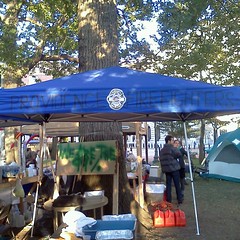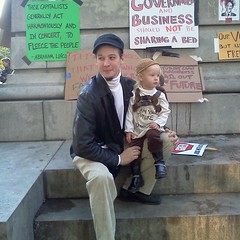13 Oct 2017
I am very excited to share exquisitecorpse.io v. 1.1.0 with the world! This is a minor interface upgrade, but a lot has changed on the backend.
Most importantly, the entire app now uses Redux! Redux is a framwork for managing application state using predictable, modular and easily-loggable actions. This is the first project I”ve used it on, and I learned a lot from it. The process of refactoring React components that managed their own state to use Redux instead was very interesting and educational.
 The only visible change you’ll notice is that when you load an individual completed poem, it now appears in a fancy modal dialog. Underlying this small adjustment is a deep rethinking of how the app treats completed poems. Previously, it loaded them all into state when it was launched, displaying only the first 50, and providing the user with a button to show more. I also wanted each poem to have a pseudo-permalink, so if you wanted to send one to a friend, for example, you could just copy the URL. So I gave each poem on the screen an
The only visible change you’ll notice is that when you load an individual completed poem, it now appears in a fancy modal dialog. Underlying this small adjustment is a deep rethinking of how the app treats completed poems. Previously, it loaded them all into state when it was launched, displaying only the first 50, and providing the user with a button to show more. I also wanted each poem to have a pseudo-permalink, so if you wanted to send one to a friend, for example, you could just copy the URL. So I gave each poem on the screen an <a> tag with an id, and let the browser handle jumping to them. The problem was: what if you had clicked the “load more poems” button before finding one you liked? When your friend pasted the URL into their browser, nothing would happen – the <a> they were requesting wasn’t on the screen yet!
To get around this, I had to do all sorts of jury-rigging with Element.scrollIntoView() and the like. Ugly stuff, and not very reliable. I was never satisfied with the way this worked, so when I gutted the application a few days ago to integrate Redux, I decided to just delete all of that code and start over. The solution: react-router! Individually requested poems are now routed by react-router and displayed in a modal dialog. Since all the poems are loaded at initialization, react-router can display any requested poem, whether or not it already appears on the screen.
 Finally, I use
Finally, I use history.push to remove the fragment (the part of the URL after the #) when the modal dialog is closed. This ensures that if the user clicks on the same completed poem from the list again after closing the modal, it will reopen – prior to this fix, its props remained the same, so React didn’t see any reason to rerender it.
The only functionality that I removed and didn’t re-add was the feature that displayed the full poem to you after you finished it. This will probably be the next update!
Consistent with Semver (specificaly, spec #7), we’re now on version 1.1.0 of Exquisite Corpse. I hope you enjoy it!
20 Sep 2017
NB: this post assumes a basic familiarity with PGP. I had almost none before starting, so if you follow the links I provide and spend a little while reading, you’ll be just as qualified to start hacking on this as I was.
I’ve recently become interested in using PGP for secure email communications. I run macOS 10.11 El Capitan, and I decided to install Enigmail, a simple PGP plugin for Thunderbird, to try it out.
Enigmail requires an existing installation of GnuPG. You can get it from the GPG Suite official installer, but I use Homebrew to install new packages whenever possible, to keep things centralized and streamline updates. Homebrew is smart about where it puts packages, and Enigmail is smart about where it looks for them, so this would be a seamless install (cue foreboding music). Step 1: brew install gnupg. Step 2: download and install Enigmail. Step 3: security!
Or so it seemed.
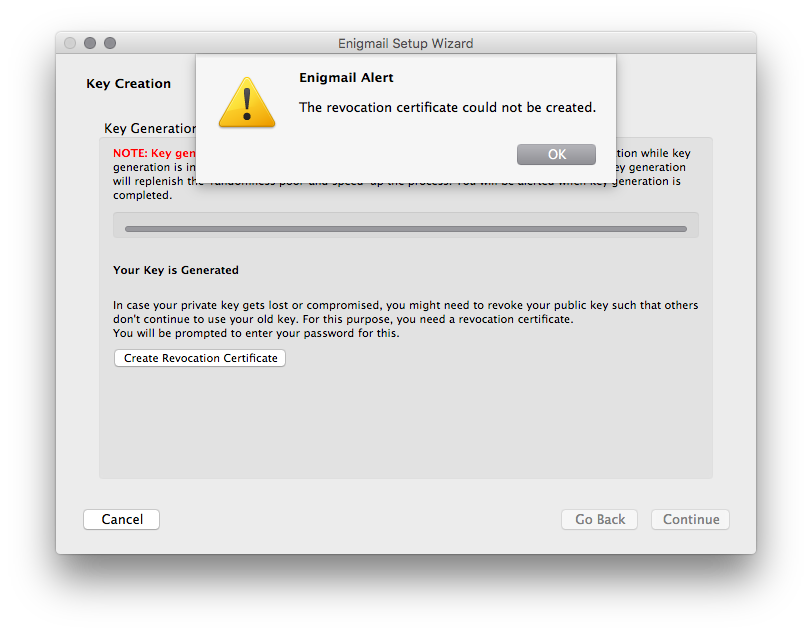
The Enigmail setup wizard successfully generated keys, but failed at the next step with: “The revocation certificate could not be created.” Revocation certificates are important, so this was a serious obstacle.
While I was able to find documentation of this error elsewhere, nobody expressly answered the question of “how do you fix this on a Mac without stepping outside the Homebrew ecosystem?” After some digging, I found the problem. Here are the dependencies Homebrew installs with gnupg:
$ brew deps gnupg
adns
gettext
gmp
gnutls
libassuan
libffi
libgcrypt
libgpg-error
libksba
libtasn1
libunistring
libusb
nettle
npth
p11-kit
pinentry
Here’s the problem: pinentry is a program for authenticating to gpg-agent (the program to which GnuPG farms out passphrase entry), but it only runs at the command prompt. Enigmail is looking for a GUI authentication program. Fortunately, the Homebrew package pinentry-mac seems to be exactly that – a GUIfied verison of pinentry.
So, brew install pinentry-mac. Then, in ~/.gnupg/gpg-agent.conf, add the line pinentry-program /usr/local/bin/pinentry-mac. This points gpg-agent to the right authentication program, so that when Enigmail asks for authentication, the user is prompted to enter the password used to encrypt their private key.
Enigmail recommends testing your setup with
pinentry <<EOT
SETDESC Hello World
CONFIRM
EOT
However, if you’ve pointed gpg-agent at pinentry-mac, you should instead run
pinentry-mac <<EOT
SETDESC Hello World
CONFIRM
EOT
If you see a graphic dialog box pop up, you’ve done it right – pinentry-mac is now capable of asking for your password. Restart gpg-agent (or logout and back in), and you should be able to step through the Enigmail setup wizard without any problems!
I hope this post helps you save some time, and happy encrypting! Oh, and you can find my PGP public key here.
27 Aug 2017
 I activated W7A/AW-013 Spruce Mountain on July 22 and DM/BW-008 Schauinsland on August 22, during my current trip to Germany. Here’s a brief description of each activation.
I activated W7A/AW-013 Spruce Mountain on July 22 and DM/BW-008 Schauinsland on August 22, during my current trip to Germany. Here’s a brief description of each activation.
W7A/AW-013 Spruce Mountain
We spent a weekend in Prescott camping in the Prescott National Forest. It was Chloé’s birthday, and our friend was calling the Prescott contra dance, so four of us drove up and spent the weekend hiking, dancing and exploring a dead railroad bridge in Prescott.
We found time for an afternoon hike before the contra dance on Saturday. We chose a nice-looking trail not too far from our campsite. Lo and behold, it led up Spruce Mountain, which my map helpfully informed me was W7A/AW-013! I had brought my new (to me) FT-817, LNR end-fed antenna and Shakespeare mast (a future post will examine my SOTA gear in more detail), but by the time we got to the top, we didn’t have long before the dance started. I opted to try an activation with my HT, and I was successful! After getting to go into the fire lookout’s tower on the summit, I got started. I put out a “CQ SOTA” call on 146.54 and got my four contacts in less than 20 minutes! In the picture below, I’m logging contacts from my operating position on the steps up the fire lookout. You can see the Shakespeare pole strapped to my bag, awaiting its moment to shine.
The next day, we drove up to Sedona and hiked in Red Rock State Park. At a small peak on one of the trails (not a SOTA summit), I set up my HF rig, but didn’t have time to finish tuning the antenna before a monsoon rolled in. Standing on a mountain top with a twenty-foot fiberglass pole wired to you is not a great look in an electrical storm, so I broke down the gear and we booked it out of the park, getting caught in heavy rain along the way. My dry bag performed beautifully during this trek – I was soaked to the skin by the time I made it out, but my gear was bone-dry.
DM/BW-008 Schauinsland
After three weeks in Berlin at JASS, I took off for Southwestern Germany. I stayed in Freiburg for two nights. On my first full day there, I hiked DM/BW-105 Schönberg, but I couldn’t make any contacts from the top. Nevertheless, a beautiful walk up and a beautiful view!
On the second day I hiked Schauinsland, and, over the course of a little more than an hour and a half, activated it! I again used my trusty HT. I even worked FDC1SK in France, and DC1SK summit-to-summit (S2S) from DM/RP-444! On this activation, patience was the name of the game. I got my first contact right after reaching the summit, called CQ unsuccessfully for a while and then sat down to eat some lunch. While eating I found a spot with some cell service and managed to spot myself, leading to one more contact. After eating, I climbed the observation tower and made one contact in about thirty minutes from the top. I was almost resigned to leaving the summit one contact short of a full activation, but I managed to make one more after I came back down from the tower!
Schauinsland is a busy summit, with many tourists, through-hikers and mountain bikers. I explained ham radio and SOTA to a number of interested people. I suspect that once I start carrying my HF gear, I’ll need to bring along one of the SOTA leaflets [PDF] to hand out, as I’ll be attracting a lot more attention.
Schönberg:
Schauinsland:
Conclusions
First of all, SOTA rocks! I get to be outside, go on gorgeous hikes and play with radios – all at the same time. It’s also a good way to continue honing my portable operating skills, which I put to use in public service events in and around Tucson. Once my HF setup is, well, set up, I expect to have even more fun and work some DX.
This was also my first time hiking outside the US. German trails seem to have much more signage on them than American ones, and there is also just more trail infrastructure overall. A trail that, in the US, might be a simple dirt footpath may well be paved in Germany. I had paper maps with me, but almost never needed them because of how well-signed the trails were.
Both of the summits I hiked were also accessible by car, and in the case of Schauinsland, by gondola. This means that a far broader range of people can access them. I saw other day hikers like me who’d been out for only a few hours, backpackers, families with small kids, elderly people, mountain bikers and more. It was nice to see the mountains being enjoyed by so many people – these are public resources, and they should be publicly accessible.
SOTA is a wonderful way for people who like radios to enjoy the outdoors, and for people who like the outdoors to learn about radio. It’s also very easy to get started – even with my portable HF rig not ready for actual field use, I completed two of three attempted activations with patience, persistence, and less power than it takes to run a CFL lightbulb. That’s pretty cool.
See you on the trail/air!
21 Jul 2017
CW: Nazis, Nazi imagery, physical aggression and general awfulness
 A small crowd turned out for the Tucson Refuse Fascism march on the evening of Saturday, July 15. We were accompanied by about 20 uniformed TPD officers, and two Nazis. Here they are in Catalina Park, shortly before we started moving.
A small crowd turned out for the Tucson Refuse Fascism march on the evening of Saturday, July 15. We were accompanied by about 20 uniformed TPD officers, and two Nazis. Here they are in Catalina Park, shortly before we started moving.
A timeline of the evening’s events
We left the park around 6:30 PM, heading straight down 4th Ave. After less than a block we took the street. TPD blocked traffic in front and behind us as we moved. We were surrounded by officers, but they kept a respectful distance and managed traffic flow to allow us to move at our own pace.
The Nazis were not keeping a respectful distance. They started off right behind us, but as we moved, Gas Mask Nazi edged closer and closer to our rear. The younger protesters were leading the march, with the older marchers in the back of our column, so I dropped to the rear with my bike, and put myself between them and Gas Mask. Meanwhile, Sunglasses Nazi took up a position on the sidewalk, filming the entire protest. They were there to provoke a scene or interfere however they could.
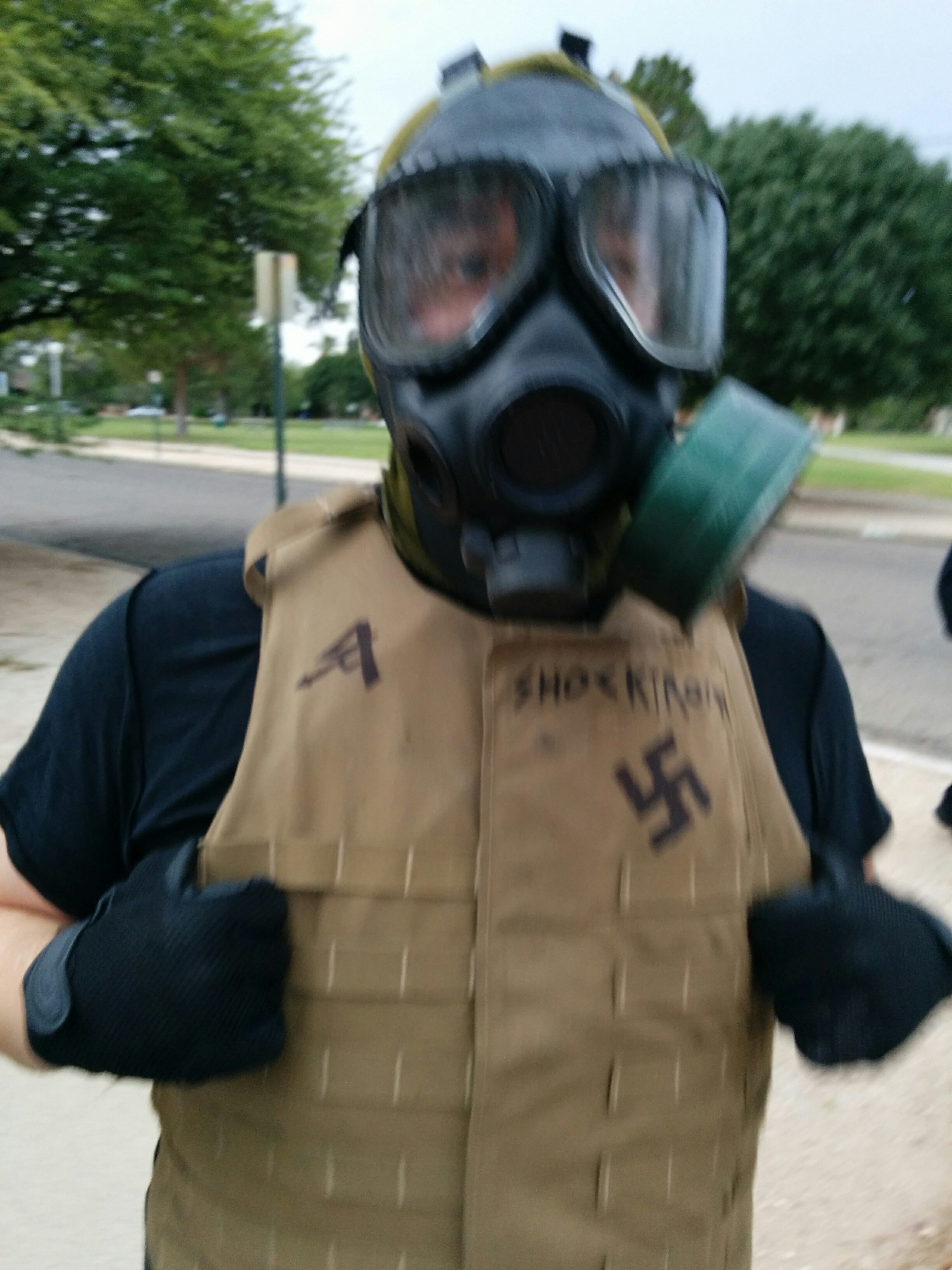 Our group was small, but spirited. Especially with our police escort, we attracted quite a lot of attention, garnering both cheers and boos from people along 4th. We talked to bystanders as we went to try to get them to join in, but the sight of a Nazi in a gas mask and flak jacket probably dissuaded a lot of them.
Our group was small, but spirited. Especially with our police escort, we attracted quite a lot of attention, garnering both cheers and boos from people along 4th. We talked to bystanders as we went to try to get them to join in, but the sight of a Nazi in a gas mask and flak jacket probably dissuaded a lot of them.
Things started to heat up as we proceeded through the underpass and down Congress. Gas Mask pushed further into our group, throwing Nazi salutes as he walked, and shouting “Heil Trump!” Around Congress and 6th, he came right up behind one of our protestors and I made a quick turn to the left, cutting in front of him with my bike. He responded by violently shoving me forward. TPD were on us immediately, and they forced me up and away from him. I hadn’t laid hands on him the entire time.
At Veinte de Agosto Park I asked the group if we could step off the road briefly. I was shaken from my first-ever physical altercation with a Nazi, and his presence was actually confusing bystanders about what our message was (no doubt this was the idea). I asked the group to take a few minutes to discuss how we could clarify our message. Gas Mask started pushing his way into our small standing circle. Again, I put myself and my bike in front of him, although somewhat more cautiously this time. In this video, you can see that Sunglasses crossed the street to film us up close, and as Gas Mask got more aggressive, TPD finally made the call to separate him from our group. They ordered him to march at least 50 feet behind us, and that was the last we saw of him. Nazis know that because their message is so unpopular, their only option is to mess up other people’s rallies. Denied a platform by TPD, he and his buddy went home (or wherever it is Nazis go).
We headed back to Catalina Park via the Valdez library, Pennington, Toole and 4th Ave. Once everyone was gathered, we did a quick debrief, at which it was universally agreed that we’d handled the Nazis very well, considering none of us had dealt with them before – and that next time we need bigger numbers!
Conclusions
Police
TPD were quite respectful – they brought us water, reminded the people leading the march when people at the end were falling behind, and took cues from us as to where to go. At several points we could have been quickly kettled had they wanted to clear us out, but they let us keep moving. We were a small group, we were there to demonstrate peacefully, and we were obviously the more sympathetic party when compared with Nazis.
The public square
The police theoretically guarantee everyone’s right to access public spaces (we’ll leave a discussion of the many people who are not afforded this right to another day – the irony of the Nazi being separated from our group in Veinte de Agosto park, former nexus of Occupy Tucson, was not lost on me). “The public square” sounds nice on the surface, but in practice it means that I got to spend an hour watching TPD protect Nazis’ right to walk down a busy street, heiling and intimidating people. Let me put this very clearly: Nazis should not be afforded a public platform, anywhere, ever. But since we live in a society that thinks they should, law enforcement officers will protect them when they do. This brings me to my final two points.
Dealing with a resurgent Nazi movement
We can’t put this back in the box. On the back of his flak jacket, Gas Mask Nazi had Sharpied “I AM HATE.” Hatred is an organizing principle for these groups. It’s not a consequence of their worldview, it’s the basis of their worldview.
We need to find ways to effectively keep Nazis from showing their faces in public. In a way, our inability to rely on the police to do this for us is a good thing. I don’t want the cops deciding who does and doesn’t get access to the streets (any more than they already do). But as the institutions (political parties, the press, unions and other civil society orgs) which should be acting as gatekeepers, moderating political discourse to forestall the emergence of radical hate groups like Nazis or the KKK, crumble one after the other, it will increasingly fall to forward-thinking people of all backgrounds to resist the legitimization of Naziism.
Safety
I considered not writing this part, but I don’t think keeping it inside is healthy or politically productive. The Nazis will be delighted to read that I was scared for my physical safety after the march. After our post-action debrief, we left the park in pairs – TPD had left, and we couldn’t be sure the Nazis didn’t follow us back.
I came home shaking, turned on all the lights and carried a flashlight for the rest of the evening, looking into dark corners and streets. I went downtown for dinner in order to be surrounded by people. I spent the entire evening watching the door of whatever building I was in. I jumped at loud noises and yelling, and nearly started a fight with a some people at a bar who gave me what I thought was an unusual look. On any other night, I’m sure I would have read it as nothing significant. We slept at a friend’s house. I haven’t put my kippah back on since the march.
Gas Mask Nazi, if you’re reading this, congratulations: you made this leftist Jew scared of the streets of his town. Mazal tov! But you did something else too: you strengthened my resolve, and, I suspect, that of everyone else at the rally. You and your pathetic cameraman lackey, you who know your disgusting hatred and fear of change won’t sell and so have to resort to “infiltrating” other groups in the tough-guy outfit you bought from the Army surplus store, you who are probably afraid to tell your friends and coworkers what you actually believe, we’re putting you on notice. These are our streets. You can’t have them.
10 May 2017
“Le cadavre exquis boira le vin nouveau.”
TL;DR: there’s a newer, prettier version of my Exquisite Corpse online poetry project – check it out here.
Exquisite Corpse began as a Surrealist parlor game in the early 20th century. Players would create collective poems or drawings by each contributing one component at a time – sometimes a word or phrase, sometimes a whole sentence.
I like to think that if the original Surrealists had access to the Internet, they would have loved it for its ability to connect people in weird and subversive ways. What makes Exquisite Corpse such a great game is the way that strangely coherent wholes are assembled from disconnected parts – you might call it emergent poetry. In a way, this is not unlike the Internet – or at least the early days of it, before the now-assumed dominance of social media, before the Web had become so corporatized. It was just a weird, slightly overwhelming and kind of beautiful place.1
So in 2008, I built an online version of Exquisite Corpse.2 The idea of opening up the process of collaboratively, pseudo-randomly creating poetry to such a huge audience was really exciting. As far as I know, this was the first web adaptation of the game (if anybody knows of an earlier one, I’d love to hear about it).
In the nine years since, there have been over 600 poems written! The site got a facelift shortly after launch when I rewrote the frontend with jQuery and AJAX.3 This made it way more useable, but jQuery has since fallen out of fashion. So over the last couple weeks I rebuilt the entire app from scratch, using a Node.js Express server for the poem API, and React for the frontend (here’s the source, including the old PHP/jQuery). In celebration, I decided the app should have its own domain name. I give you: exquisitecorpse.io.
I’m excited for this project to enter its next phase – it’s now running on some of the most up-to-date web frameworks, and is more functional and bug-free than ever before. Happy writing, netizens!
1: Anil Dash has written beautifully about what the web used to look like.
2: Warning: serious vintage Harpo Jaeger blog posts ahead. Though to be honest, I still get pretty excited about Dingley Dell.
3: And I definitely still get excited about snazzy UI elements.
14 Feb 2017
I recently purchased a Kenwood TH-D72A, which has a built-in GPS & TNC for APRS use. After getting APRS configured and taking a few walks around town to test the SmartBeaconing™ settings, I started thinking more deeply about the actual use cases for this fine HT. I’ll be carrying it at 24HOP this weekend as I follow the bike trails on foot; in addition to beaconing my position frequently enough to be useful for Net Control, I also obviously need to be available on the FM voice frequency. The TH-D72A, like any halfway-decent HT, can monitor two frequencies simultaneously, but I was concerned that the raw APRS audio1 might make it hard to hear voice transmissions. I tested this out by walking around the neighborhood during a 24HOP planning net while sending regular APRS packets. Sure enough, it was nigh-impossible to follow conversations on the repeater. Clearly, this wouldn’t work for the event itself.
The TH-D72A lacks any sort of “APRS mute” option – you can’t turn off the audio output while the TNC is on. Other hams have gotten around this by modifying the audio balance settings, so that only the desired channel actually outputs to the speaker. This is time-consuming and has to be reset by hand when changing to a different frequency, leaving a lot of room for user error. There had to be a better way.
The solution: tone squelch! I programmed a separate APRS channel with a 67.0 Hz2 receive tone. Packets are received, decoded and stored exactly as before, but because the squelch circuit never opens (standard practice is to transmit APRS without any tone), I don’t hear them.
There was one more question: would the TH-D72A’s packet send/receive/receive-mine audio alerts3 still work? The answer: yes! I took the radio out for another spin around the neighborhood; the beeps were just insistent enought that I was constantly aware of how I was doing, but I could still clearly hear voice transmissions on the other channel. Success!
I highly recommend this workaround for anybody using APRS in any kind of public service situation where there’s a need for both consistent beacons and reliable voice communications.
1: For reference, here’s what raw APRS audio sounds like.
2: Any tone will work for this.
3: This radio can be configured to emit one tone when it beacons, another when it receives one of its own packets back from a digipeater and another when it receives a packet from another station. I’ve disabled the last one; way too many beeps. But the first two are quite useful. Beep-on-send gives me realtime feedback about whether my SmartBeaconing™ settings are working how they should, or if something else has gone wrong that’s preventing regular updates. And beep-on-receive-mine is a good indication that my packets are being picked up – not perfect, but good enough for most cases. (Since this is an HT running 5W, it’s a lot easier for me to hear the digi than for the digi to hear me, so the scenario where my packet is received but I don’t hear it being repeated is an unlikely edge case. In other words, if I don’t hear my packet come back, it’s probably because it never made it to the digi.)
20 Aug 2016
I wrote a web application called gcal vacate to help me with a tricky calendar issue. While traveling in Europe this summer, 9 hours ahead of Mountain Time (AZ), all of my repeating events showed up at horribly inconvenient times. Evening things would be at 5 in the morning. Morning things late in the evening. I have daily, weekly and monthly events, so my calendar was kind of clogged. I add things to my calendar that I actually go to on a regular basis, so simply deleting all future recurrences of the events was out – they wouldn’t be here when I got back home. Obviously, deleting every instance of every repeating event individually would have taken a long time and been boring. I can’t imagine I’m the only person who’s ever had this problem, so I decided I’d write a web app to bulk delete all instances of a repeating event between specified boundary dates. I think this app is really useful, and I learned a ton about object-oriented Javascript, jQuery, and RESTful APIs while writing it.
You can use it here. A little more info is on the readme/credits page. Enjoy, and (if you like) let me know what you think on Twitter.
26 Apr 2016
Today I begin the 2016 Grand West Coast Trainventure, in which I take Amtrak from Seattle, WA back home to Tucson, AZ. Why, you may ask? Because trains are awesome, and the Coast Starlight is supposed to be one of the most beautiful routes in the country. I’ve wanted to take it for some time, especially after moving to Tucson via Amtrak from Boston.
Did I mention trains are awesome?
I depart Seattle this evening (on the Cascades, actually), arriving in Portland tonight. I’ll stay there for a few days to visit friends, then proceed to the SF Bay, where I’ll stay for another few days. Finally, I take the Coast Starlight the rest of the way down to LA, change to the Sunset Limited/Texas Eagle and end up back in Tucson.
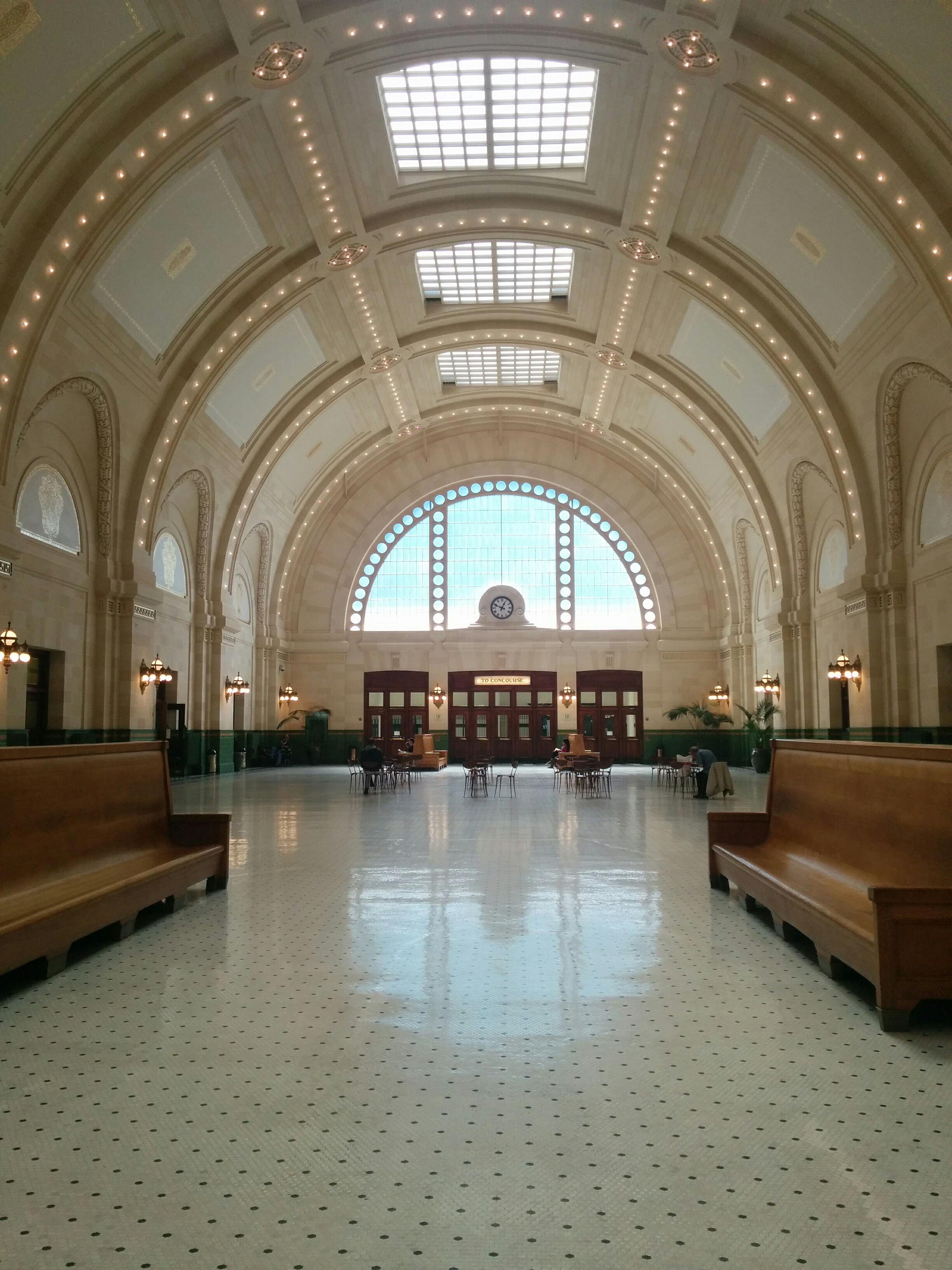 Here’s a nice picture I took today of Seattle’s Union Station. Unfortunately, Amtrak trains depart from a different station (King Street), but that one looks nice too. I’ll try to get a good picture on the way out. And you can certainly expect lots of pictures, or at least some posts, from the train (if the Internet is passable) or my various stops along the way.
Here’s a nice picture I took today of Seattle’s Union Station. Unfortunately, Amtrak trains depart from a different station (King Street), but that one looks nice too. I’ll try to get a good picture on the way out. And you can certainly expect lots of pictures, or at least some posts, from the train (if the Internet is passable) or my various stops along the way.
Lastly, I’m going to try out some of the frequencies listed here to see if I can pick up any dispatch/crew traffic along the way. It’ll be interesting to start learning how that all works.
27 Mar 2016
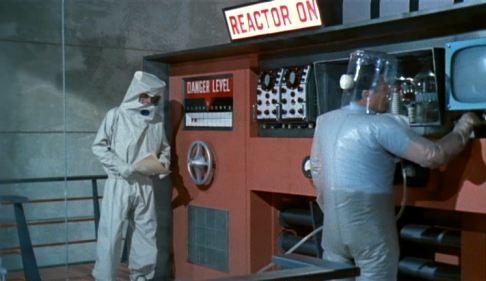 I returned from the RST Hamfest yesterday with an excellent pile of scrap electronics, including a switched six-outlet unit comprised of two standard junction boxes bolted together, with about 25’ of cord. I’ve seen similar units in a lot of shacks; when you have a bunch of different radio units and accessories, it’s nice to be able to power the whole thing off with one switch. I also picked up a nice little red indicator light which is straight out of the Adam West Batman series or Dr. No. (img src)
I returned from the RST Hamfest yesterday with an excellent pile of scrap electronics, including a switched six-outlet unit comprised of two standard junction boxes bolted together, with about 25’ of cord. I’ve seen similar units in a lot of shacks; when you have a bunch of different radio units and accessories, it’s nice to be able to power the whole thing off with one switch. I also picked up a nice little red indicator light which is straight out of the Adam West Batman series or Dr. No. (img src)
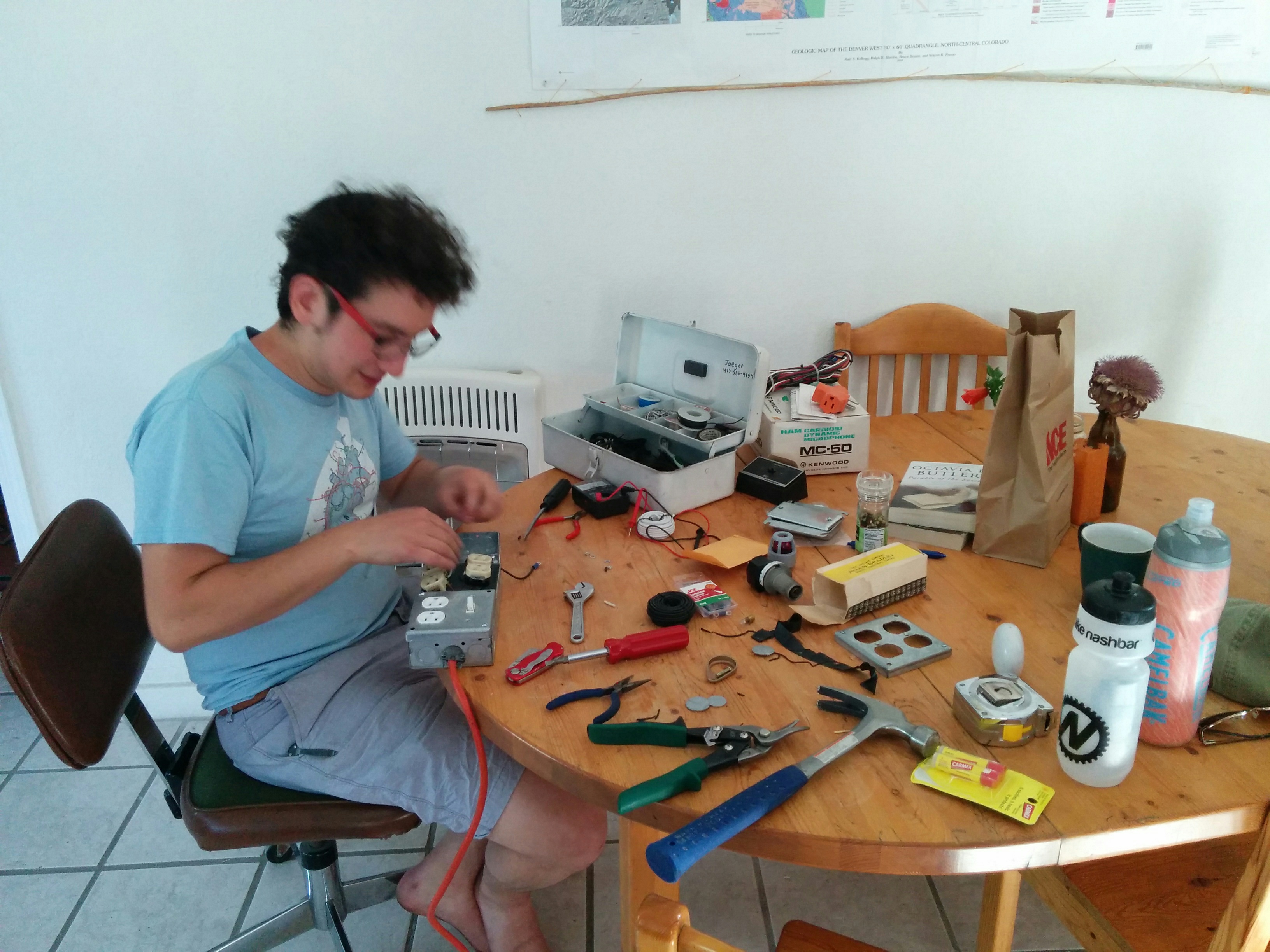 After unloading my haul and looking it all over, I realized that a set of a switched outlets and an over-dramatic red indicator light are a natural combination. So I combined them. Outlets are made to be wired in parallel banks, so it wasn’t hard to figure out where to wire in the light. My ham training stood in me good stead! After a couple runs to the local hardware store (why is it that whenever you decide not to bring your piece with you, you can’t find what you need, and whenever you preemptively bring it, it ends up being extraneous?), I had what I needed.
After unloading my haul and looking it all over, I realized that a set of a switched outlets and an over-dramatic red indicator light are a natural combination. So I combined them. Outlets are made to be wired in parallel banks, so it wasn’t hard to figure out where to wire in the light. My ham training stood in me good stead! After a couple runs to the local hardware store (why is it that whenever you decide not to bring your piece with you, you can’t find what you need, and whenever you preemptively bring it, it ends up being extraneous?), I had what I needed.
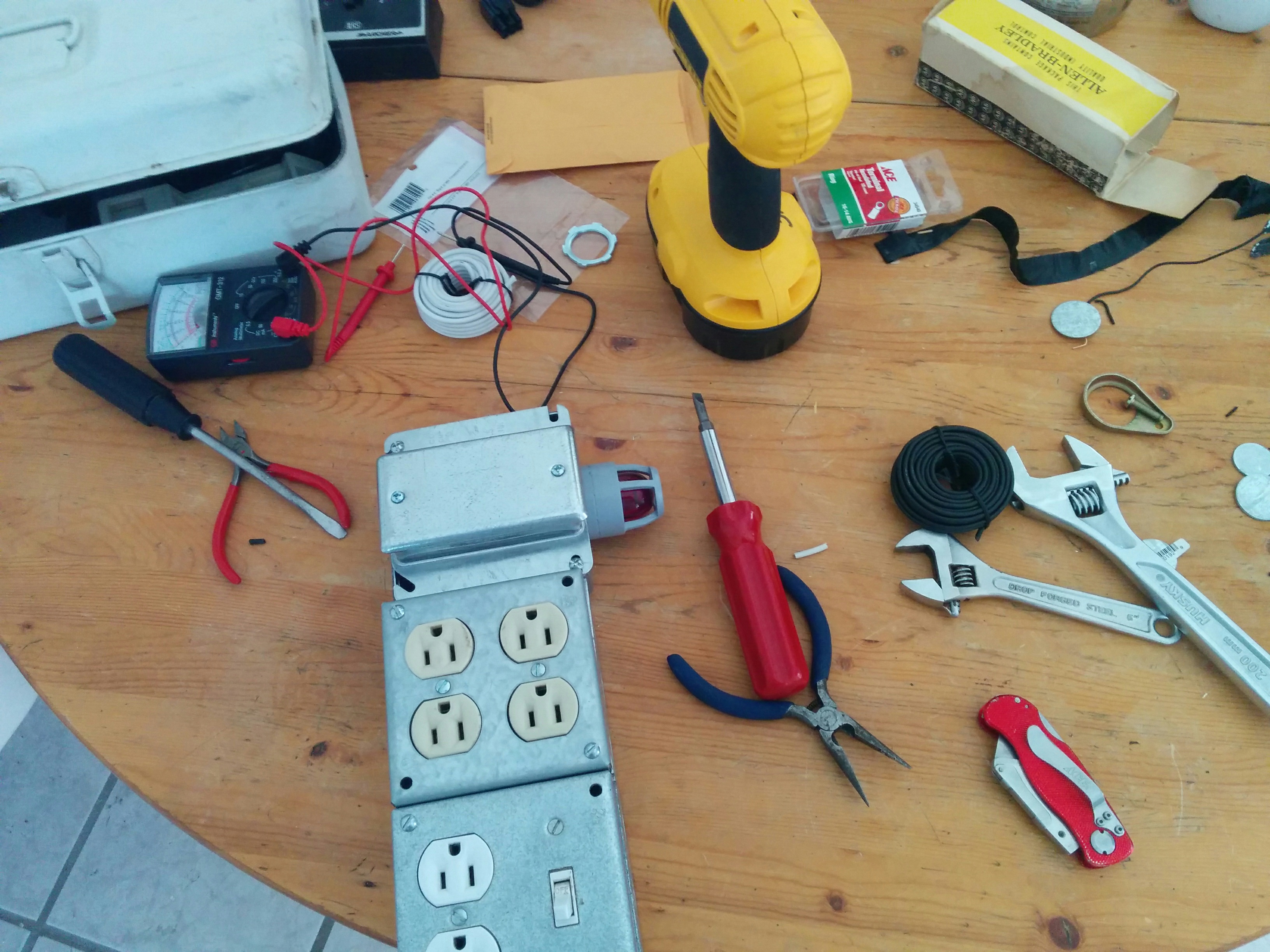 I bought a new junction box and and mounted the light in it. The portion of the indicator light that lives inside the box is a little bulky, so it was necessary to use some creative hardware to accomodate. Once I integrate this power supply unit into my radio setup (a subject for a future post), I may decide to reconfigure it slightly to optimize placement and visibility of the indicator light, and based on space constraints. But the leads I wired in are long enough to accomodate a lot of possible permutations, so it shouldn’t be hard. And it works!
I bought a new junction box and and mounted the light in it. The portion of the indicator light that lives inside the box is a little bulky, so it was necessary to use some creative hardware to accomodate. Once I integrate this power supply unit into my radio setup (a subject for a future post), I may decide to reconfigure it slightly to optimize placement and visibility of the indicator light, and based on space constraints. But the leads I wired in are long enough to accomodate a lot of possible permutations, so it shouldn’t be hard. And it works!
The important insight was that the light needed to be wired across the outlets; that is, in parallel, not series. It would be neat to build an indicator bank that shows whether power is flowing through each of the 6 outlets (for troubleshooting equipment, e.g.), but the idea here was to know when the switch was on, not when power was being drawn. As it stands, this light indicates the presence of 120v across the outlets. Cool!
28 Feb 2016
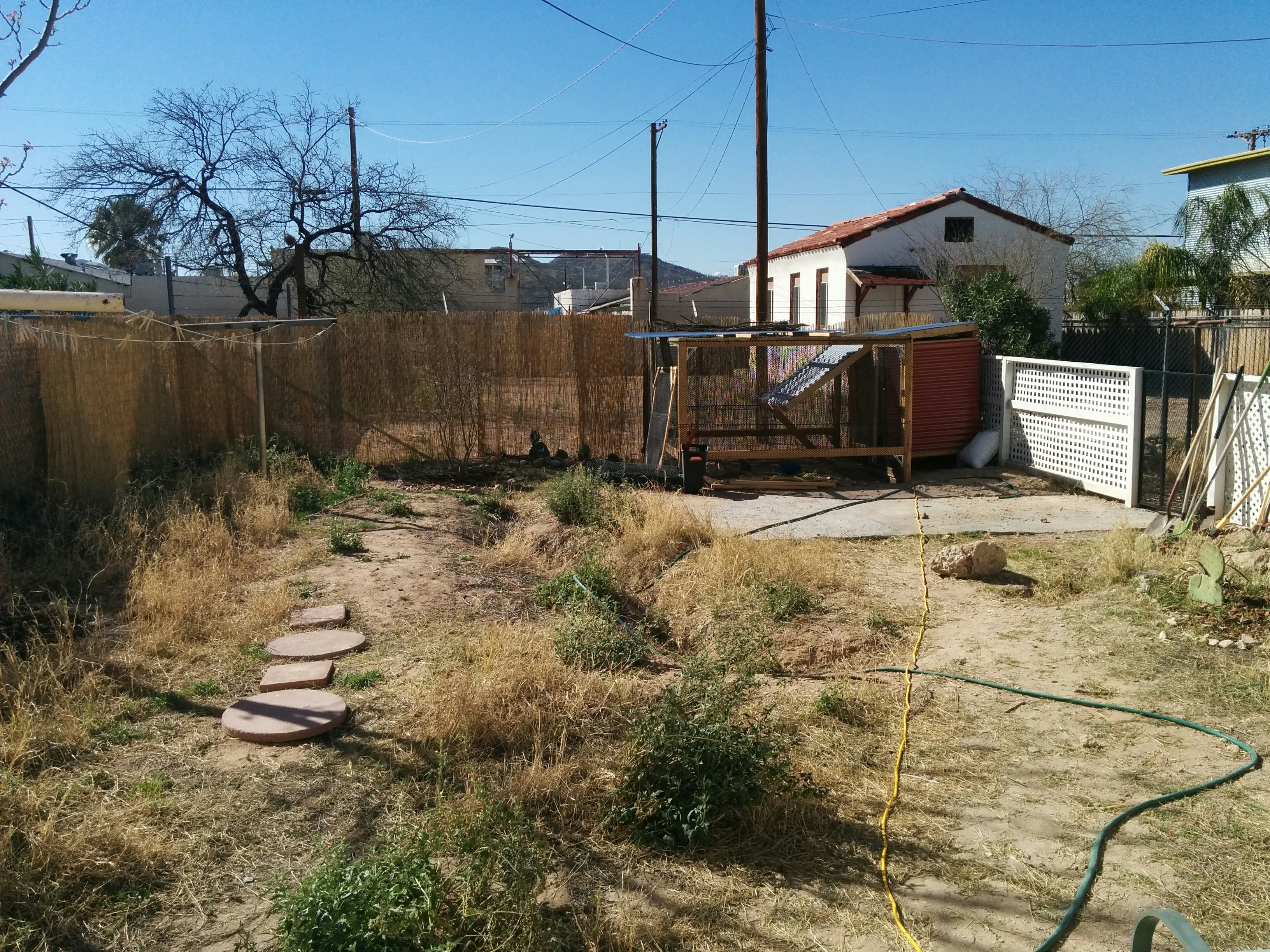 Over the last couple weeks I’ve been working on a number of house projects. The biggest is a coop and run for our new chickens! The run is about 8’ x 8’, and the (numerous) corner brackets ensure that it’ll remain quite sturdy even with untreated wood (which you can use out here in the desert). The uprights are sunk about 1’ into the ground. It took a lot of digging and pickaxing to get through the caliche layer, but that gives our run something akin to concrete footings, so I think it was worth it for the extra stability. This thing will probably outlast our actual house at this point.
Over the last couple weeks I’ve been working on a number of house projects. The biggest is a coop and run for our new chickens! The run is about 8’ x 8’, and the (numerous) corner brackets ensure that it’ll remain quite sturdy even with untreated wood (which you can use out here in the desert). The uprights are sunk about 1’ into the ground. It took a lot of digging and pickaxing to get through the caliche layer, but that gives our run something akin to concrete footings, so I think it was worth it for the extra stability. This thing will probably outlast our actual house at this point.
A desert-adapted chicken coop
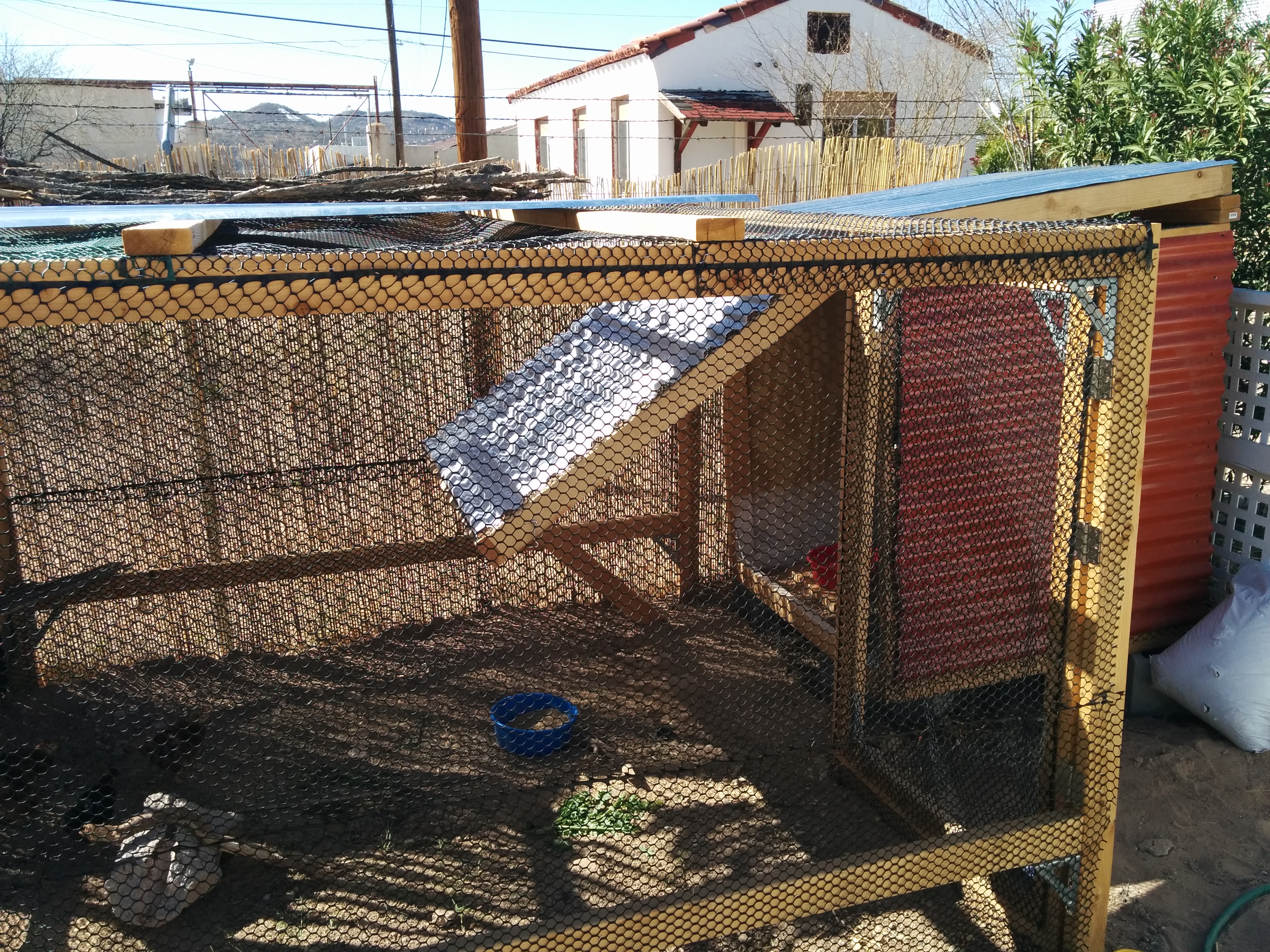 The coop is an approximately 4’ x 4’ cube, with 1/4” plywood bottom and back. The right side and front (from these photos’ perspective) are simple poultry mesh with a corrugated synthetic sun guard material. The top and left side have 2x4 frames hinged to the coop. The top has poultry mesh under the corrugated tin, so it can be left open during the day for additional airflow. The left side opens into the run.
The coop is an approximately 4’ x 4’ cube, with 1/4” plywood bottom and back. The right side and front (from these photos’ perspective) are simple poultry mesh with a corrugated synthetic sun guard material. The top and left side have 2x4 frames hinged to the coop. The top has poultry mesh under the corrugated tin, so it can be left open during the day for additional airflow. The left side opens into the run.
The fit between the run and the fence is quite tight, and we didn’t sink the cinder blocks the coop sits on quite low enough, so in another week or two we’re going to have to muscle the whole thing out of there and relevel the ground below it. This will also give the side and top hinges some more room, as they’re running up into the top beam of the run right now. But it works, and the chickens are doing great. Here’s a YouTube channel with videos of them when they were still inside.
Sauerkraut & bread
 I’ve started making sauerkraut! I’m using this recipe, and it really is as easy and delicious as it sounds. We are also developing a dutch oven bread recipe, based on the NYT’s outrageously popular no-knead bread. The modification that’s given us the best results so far is to double the yeast and add 1 tsp of sugar. Increasing the cook time in the dutch oven (that is, before taking the lid off to finish browning) gives a thicker crust, too.
I’ve started making sauerkraut! I’m using this recipe, and it really is as easy and delicious as it sounds. We are also developing a dutch oven bread recipe, based on the NYT’s outrageously popular no-knead bread. The modification that’s given us the best results so far is to double the yeast and add 1 tsp of sugar. Increasing the cook time in the dutch oven (that is, before taking the lid off to finish browning) gives a thicker crust, too.
Olives
There are olive trees all over Tucson, including a lot on the U of A campus. We picked about half a grocery bag full of them back in November and have been brine curing [PDF] them ever since. Here’s what they look like now (one of four jars). They’ll likely be ready within the next few weeks.
14 Jun 2015
(If you want to skip my summary and just read the paper, it’s here.)
Almost a year ago, Professor Steven Salaita lost a job. Or did he? The debate about whether the University of Illinois abridged his academic freedom rights has raged since last August, when the news became public. The most recent update: the American Association of University Professors has censured the University. Censure is the highest penalty the AAUP can impose on an institution. It will do serious damage to UIUC’s status in the academic world.
Last fall, I researched the case of Professor Salaita in some depth for an undergraduate course on academic freedom, taught by Luther Spoehr at Brown University. A number of people have requested that I post that paper publicly; today I’m doing so. There have been several important updates since I wrote it – Prof. Salaita filed a lawsuit to go after UIUC donors who were likely behind his firing, he won a FOIA case, and now the censure – but my main conclusions still hold up: that UI Chancellor Phyllis Wise acted in contradiction of the principles of academic freedom when she fired Professor Salaita after public outcry caused by his tweets during last summer’s Israeli bombardment of Gaza.
Some excerpts from the paper:
Both the legal and procedural arguments fail to adequately settle the issue. The legal argument can get us only as far as determining whether Professor Salaita had academic freedom rights with respect to the University of Illinois. The procedural argument can get us only as far as determining whether the University acted in accordance with its own policy. The true question is whether the merits of Salaita’s dismissal stand up to the rather high bar that the standard conception of academic freedom imposes.
…in the absence of specific charges as to how Professor Salaita’s angry and rude tweets affected his abilities as a scholar or a teacher (beyond vague and unsubstantiated claims of potential student discomfort), it is inappropriate to consider the content or style of his remarks in a hiring decision.
Finally:
Pending the University of Illinois Academic Senate investigation, I would not be surprised to see an AAUP Committee A investigation of this case, with censure of the University a distinct possibility, if not a likelihood. The Illinois AAUP has already weighed in, and the local Campus Faculty Association also believes an AAUP investigation is likely.
My predictions were accurate. The AAUP has vindicated Professor Steven Salaita about as thoroughly as is possible. Perhaps UIUC will reinstate him. Probably not. Perhaps the AAUP’s censure will increase the chances he’ll be hired elsewhere.
This case is a powerful reminder of exactly what happens when the limits of acceptable political discourse are set by wealthy people and institutions with their own interests. If academic inquiry is to remain a tool of progress, it is vital we learn from the case of Professor Steven Salaita and vigorously resist any attempts to impose political tests on university faculty, whether or not we agree with their particular opinions. This is a lesson that politically-minded people of all different beliefs must internalize.
“First they came for the loudmouthed professors, and I did not speak out because I was not a loudmouthed professor…”
Read the full paper: “You Can’t Fire Me; I Quit!” Academic freedom and the case of Steven Salaita”
15 Nov 2011
Criticisms of #Occupy have often focused on its lack of a centralized agenda. My reporting from Occupy Providence, especially during the week that I lived there, has focused on contextualizing individuals’ goals in the broader movement. Learning more about the many issues and viewpoints that are represented at any #Occupy event has been fascinating and informative. At times divergent, they were united by their shared space; we Occupied Together. Occupying Together implies not just sleeping in the same park, but being part of the same movement with people with whom you actively disagree. As a community-building model and decision-making process, this is powerful.
But without the shared space, what does #Occupy do?

Last night, occupiers in Zucotti Park were evicted with tear gas and pepper spray.Journalists were removed and prevented from documenting (see Josh Stearns’ excellent ongoing tracking of journalist arrests at #Occupy events everywhere). It bears repeating: when the police prevent journalists from filming an event, it’s almost always because they or the decision-makers don’t think that what they’re doing is defensible (or legal see below). Furthermore, it goes without saying that denying the public information about current events is a very good tactic in preventing them from mobilizing, which is pretty clearly the motive here.
All this said, there’s been some interesting commentary on how this fiasco could end up benefiting #Occupy. Here’s Ezra Klein:
The occupation of Zuccotti Park was always going to have a tough time enduring for much longer. As the initial excitement wore off and the cold crept in, only the diehards — and those with no place else to go — were likely to remain. The numbers in Zuccotti Park would thin, and so too would the media coverage. And in the event someone died of hypothermia, or there was some other disaster, that coverage could turn. What once looked like a powerful protest could come to be seen as a dangerous frivolity.
Now more than ever, the future of #Occupy depends on mobilizing around concrete goals. Lots of people within the movement are going to resist that, but there’s only so long they can fight over the physical space of Zucotti Park (or any other location) without becoming irrelevant. The occupations were an excellent way of bringing people together and getting attention. Mayor Bloomberg has done us a favor by throwing #Occupy back into the spotlight, but it seems likely that this sort of eviction is going to occur elsewhere as well in Oakland, it already has. It’s time to use the renewed media attention, as well as the ongoing legal battle over #OWS’ right to occupy Zucotti Park, to organize Occupiers everywhere around a core set of political principles and achievable goals.
I’m debating on exactly this topic on Friday at 4. If you’re in the Providence area, please come by, share your opinions, and join the conversation!
11 Nov 2011
The situation at Occupy Oakland continues to deterioriate:
A man was shot to death on Thursday near a downtown Oakland plaza where hundreds of anti-Wall Street activists have camped out for a month, stoking renewed calls by some city officials to evict the protesters.
It’s not clear yet whether the victim and/or shooter were involved in Occupy Oakland, or just near it. Either way, this is bad press something that Occupy really needs to avoid. That said, this is dumb (same article):
“Tonight’s incident underscores the reason why the encampment must end. The risks are too great,” [Oakland Mayor Jean] Quan said. “We need to return (police) resources to addressing violence throughout the city. It’s time for the encampment to end. Camping is a tactic, not a solution.”
Quan certainly didn’t seem too concerned about wasting police resources on October 25th. But there’s a larger lesson to be learned here: #Occupy is running out of capital. If the movement doesn’t translate to substantive political action very soon, it will lose steam.
“Political action?” you say? “Politics is messy and full of special interests. Politics will dilute the message and subvert Occupy’s grassroots, democratic nature.”
Well, yes. But “politics” doesn’t just mean lobbyists and committee hearings (although those are pretty important too). Politics is the process of organizing constituent groups around issues with specific goals in mind. Occupy brought together a lot of people with a lot of ideas, and that’s been incredibly valuable in and of itself. Now it’s time to make the jump to issue-based organizing. That doesn’t mean we have to give up the incredible democratic and people-powered nature of Occupy, it just means that there needs to be some serious top-down leadership to put together real, workable campaigns.
For example:
…a few minutes ago the president sent the pipeline back to the State Department for a thorough re-review, which most analysts are saying will effectively kill the project.The president explicitly noted climate change, along with the pipeline route, as one of the factors that a new review would need to assess. Theres no way, with an honest review, that a pipeline that helps speed the tapping of the worlds second-largest pool of carbon can pass environmental muster.
And he has made clear that the environmental assessment wont be carried out by cronies of the pipeline companythat it will be an expert and independent assessment.
That was veteran environmental activist Bill McKibben on the Keystone XL pipeline, which, thanks to an ongoing campaign including over one thousand arrests and culminating in a giant protest at the White House last weekend, looks decreasingly likely to be approved. This is one of the environmental movement’s biggest victories in an uncomfortably long time. It came about because a) there are a lot of people who care enough about the issues to go to DC and protest in person, and b) because a few people took charge and coordinated a highly visible event, paying serious attention to strategy and media outreach.
What can #Occupy learn from this? That it’s not enough to have passionate people on your side. If it were, we’d never have gone to war in Iraq. We’d never have passed the PATRIOT act. We’d never have assassinated an American citizen on foreign soil without anything even resembling due process. And we wouldn’t continue using unmanned drones to carry out indiscriminate attacks on uncertain targets.

So far, #Occupy’s energy has been focused on physically sustaining the occupations. That takes a lot of work, and the amount that’s been accomplished is nothing short of incredible. But if Occupy wants to move forward and make a real political difference (like, dare I say, the Tea Party?), we need substantive goals and action strategies. It’s clearly possible to turn people out for actions; Occupy Providence had a really strong presence a few weekends ago in a demonstration to support their continued occupation of Burnside Park, and have also been sending folks to Bank of America in groups to close their accounts and move their money to local banks. But actions like this have largely been invisible to the media and not coordinated at a national level. That can’t continue.
Living at Occupy Providence for a week was a really incredible experience. I have real faces and experiences to consider when I think about the movement faces and experiences other than my own. I try to see things from the perspective of the homeless, the unemployed, and those who’ve been far less privileged than I in any number of ways. The commitment and kindness I’ve encountered at Occupy Providence has been nothing short of inspiring.
I hope that others feel the same way and I hope that inspiration moves us to question our assumptions about what it means to be a movement. Grassroots support and centralized leadership aren’t mutually exclusive; rather, they’re vital co-components of any successful activism strategy.
I want desperately for #Occupy to succeed. We need to define success and articulate a clear plan of action to get ourselves there. Complicated problems require complicated solutions, so let’s not sell ourselves short.
19 Oct 2011
It’s commendable that Israel cares about its soldiers so much that it’s willing to trade over 1000 prisoners for one of them. I wish that were true of our country we’ve stopped noticing the bodies coming home from Afghanistan, much less the injured or captured. But a friend of mine made a good point yesterday: the simple math here implies that soldiers, perhaps by virtue of being uniformed, rather than non-uniformed, combatants, are inherently more valuable. Armies are certainly not the same as terrorists, but at the end of the day, they’re both trying to kill people. I’m troubled by the implication that soldiers inherently deserve freedom while combatants do not especially given most armies’ historical lack of internal accountability.
I’m not trying to claim that Gilad Shalit is complicit in some unspecified war crime. But if I had a reason to believe he might be, he’d still be elevated to hero status because of his uniform. Palestinian prisoners aren’t afforded that privilege. Domestically, yes, but internationally, no. So in a way, this exchange further entrenches the narrative of the peace-loving Israeli and the revenge-driven Palestinian.
I’m overjoyed that a young man who’s been held in cruel conditions for an unspeakable amount of time is returned to his family. I hope that we’ll come to recognize Palestinians as deserving the same dignity we instinctively afford to Israeli soldiers.
19 Oct 2011
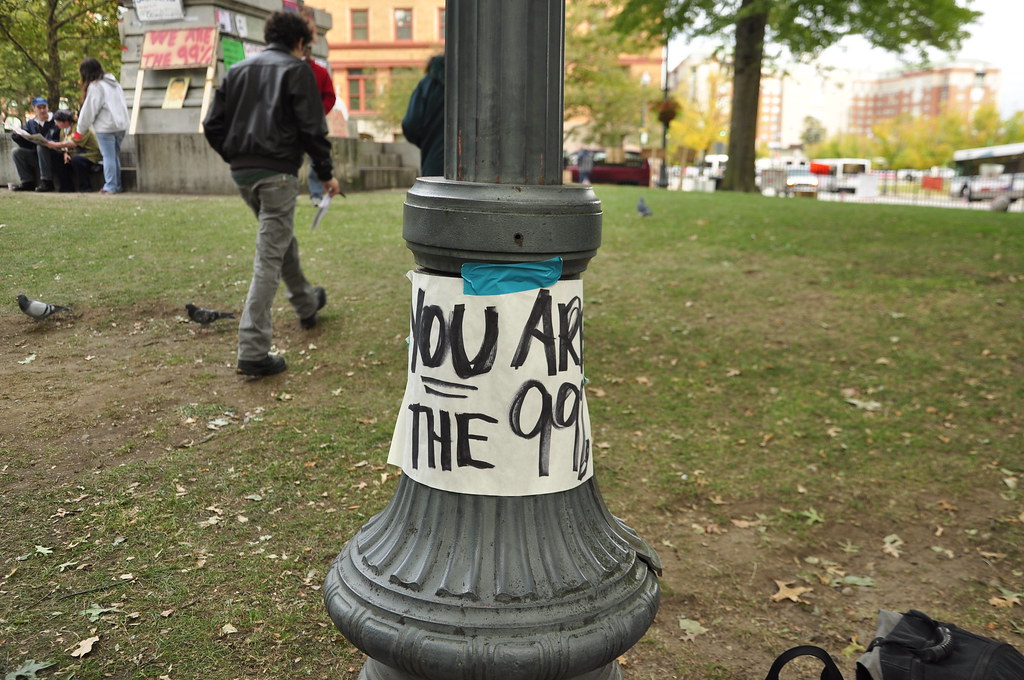 I don’t want to be blindly supportive of the Occupy movement. I don’t want to blindly condemn it. I don’t want to be blind at all. In a movement as experiential as this one, joining in is the best way to learn. I’m describing myself as an embedded journalist-activist, and, while I largely support the movement’s (ethereal) goals, I’m retaining some measure of aloofness. From a journalistic perspective, this lets me critique the movement while being involved enough to feel like I’m part of a real and constructive conversation, rather than acting like a distant analyst with little connection the emotions and ideas this movement is bursting with.
I don’t want to be blindly supportive of the Occupy movement. I don’t want to blindly condemn it. I don’t want to be blind at all. In a movement as experiential as this one, joining in is the best way to learn. I’m describing myself as an embedded journalist-activist, and, while I largely support the movement’s (ethereal) goals, I’m retaining some measure of aloofness. From a journalistic perspective, this lets me critique the movement while being involved enough to feel like I’m part of a real and constructive conversation, rather than acting like a distant analyst with little connection the emotions and ideas this movement is bursting with.
My friend Noa and I arrived at Burnside Park at about 3:00 AM last (Monday) night, and after several interviews, fell asleep to the sounds of laughter and walkie-talkies, in a seven-person community tent (open to all; first come, first served). As early as 5:00 AM, cars drove by honking in support of the signs all along the fence around the park.
I’ll be staying here for the rest of the week. I’m posting now from the tent I’ve set up for myself and other Brown students. Noa took all of the pictures here, as well as more which can be found on my Flickr.
Artemis: The Red Tape Army
Artemis (known to all here as “Ma”) is coordinating the Red Tape Army, which began as a small corps of medical volunteers, and has expanded its duties to include general hospitality tasks such as distributing blankets and food. Anotherone of Artemis’ stated goals is to hug every single person who comes through the park.
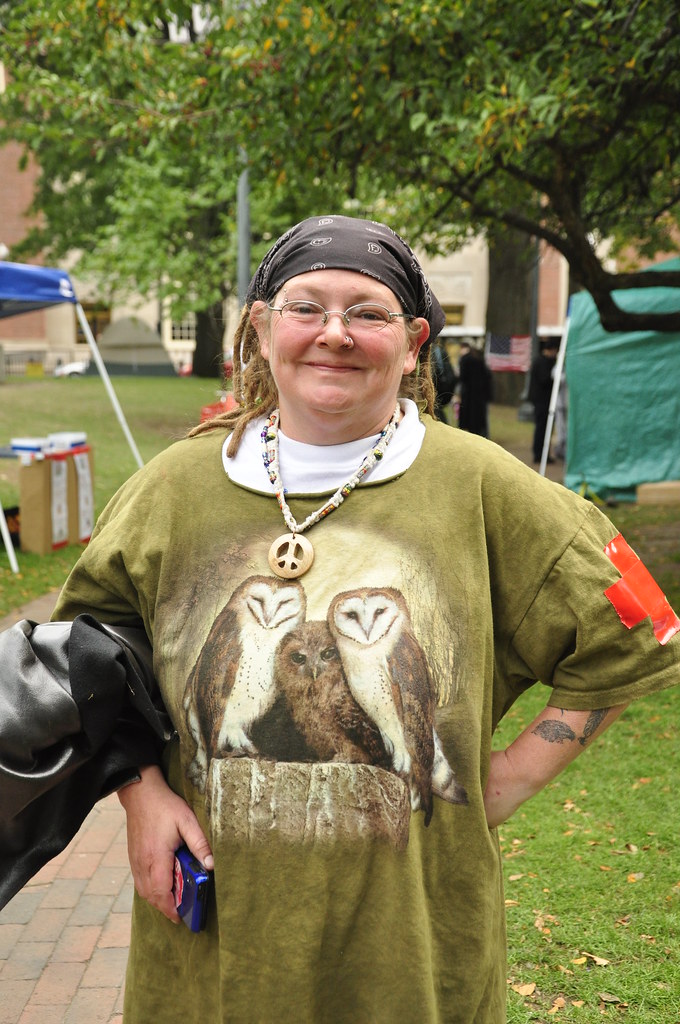 From 1999 to 2001, Artemis was homeless, living on Thayer Street on College Hill. The Finlandia co-op often provided her with food, and she also recalls sleeping on their couches regularly. From our conversation, it was readily apparent that she remains highly aware of the unique challenges the homeless face; much of her work here is in a sort of unofficial homeless-outreach capacity. She buys the homeless “kids” $1 pizza at the nearby 7-11, and has brought a lot of them into Occupy Providence by helping them out in this way. Her compassion for the many homeless who were already living in Burnside Park when Occupy came in, as well as for those who’ve joined after, is readily apparent. She told me of a homeless man whom she helped out one night; he returned the next day to tell her “Because of you, I didn’t commit suicide.” She says “That’s what it’s about – I don’t care about the political end.”
From 1999 to 2001, Artemis was homeless, living on Thayer Street on College Hill. The Finlandia co-op often provided her with food, and she also recalls sleeping on their couches regularly. From our conversation, it was readily apparent that she remains highly aware of the unique challenges the homeless face; much of her work here is in a sort of unofficial homeless-outreach capacity. She buys the homeless “kids” $1 pizza at the nearby 7-11, and has brought a lot of them into Occupy Providence by helping them out in this way. Her compassion for the many homeless who were already living in Burnside Park when Occupy came in, as well as for those who’ve joined after, is readily apparent. She told me of a homeless man whom she helped out one night; he returned the next day to tell her “Because of you, I didn’t commit suicide.” She says “That’s what it’s about – I don’t care about the political end.”
It would be easy to decry the members of the Providence homeless community as free-riders; they’re benefiting from the donated tents, blankets, and food and drink that Occupy is collecting and distributing. However, the Occupiers consistently show an impressive amount of camaraderie with the homeless, who otherwise remain invisible to society in many ways. This kind of solidarity through cohabitation anddirect action is a testament to Occupy’s willingness to live out its principles of inclusion.
In yet another display of the pragmatism I’m discovering in all corners of Occupy, Artemis fully understands that we’re in a tenuous situation here. Of the future of Occupy Providence’s physical presence, she remarked “The cops have been great, but we’re pushing it now.”
Felicia: “We need to be heard.”
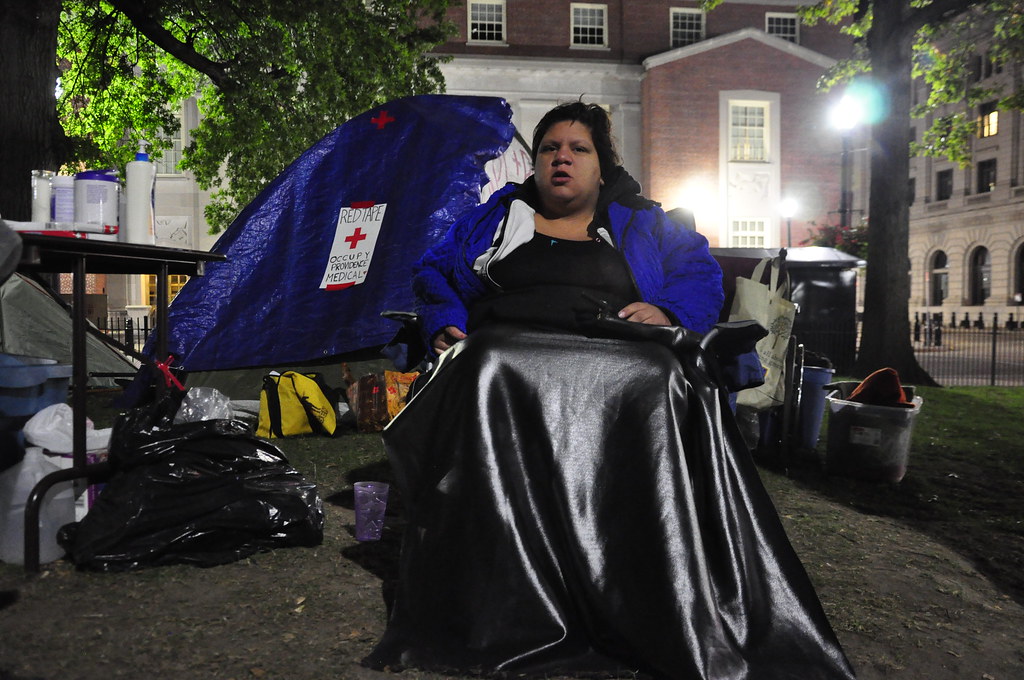
Felicia is a member of the Red Tape Army. She was working the 2-8 shift when I talked with her outside the main medical tent. She’s in business school, and got involved in Occupy on Saturday night. She came back after church on Sunday, and has been here ever since. I started to ask her about some of her reasons for being here, but was interrupted by a squawk from her walkie-talkie; all the medical volunteers carry one. Once she confirmed that she wasn’t needed, we continued. “I can’t really pick one thing,” she responded when I named a few of the reasons others had given for their involvement. “We need to be heard.”
Felicia, too, underscored the message of respect for the police. “If it wasn’t for them, we wouldn’t be here.” She also spoke about respecting the park and keeping it clean. I asked her about next steps – she wants Occupy to start talking to politicians, joining and organizing rallies at the statehouse and City Hall – to be heard everywhere possible.
Going forward, a focus on visibility of the kind Felicia expressed will be vital. If Occupy doesn’t continue to expand into new areas, to bring in new attention, energy, and ideas, it will stagnate. To really be heard, we need to constantly look for new ways to express ourselves.
Dave Taveres: “I am a capitalist, but at the same time, that doesn’t give you the right to take advantage of people.”
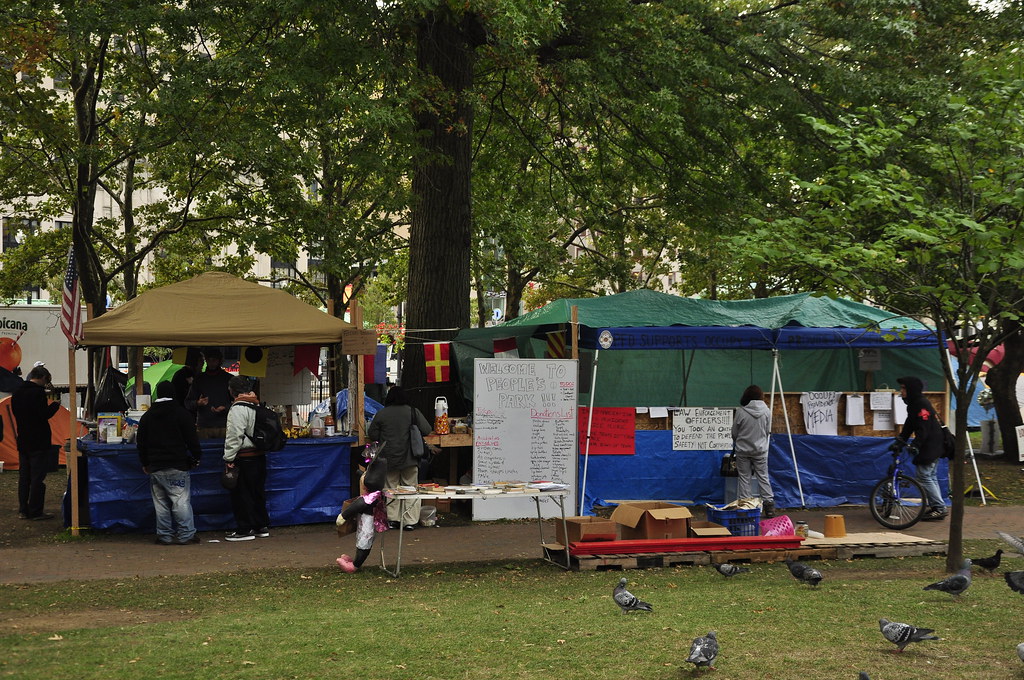
I stopped Dave as he walked along the edge of Burnside Park, observing the signs and the tents clustered inside. He works in Pawtucket (he described his job as “blue-collar”), and has seen Occupy’s presence here when he takes the bus at Kennedy Plaza next to the park. He’s worked a lot with the homeless in the past, and agrees with Occupy’s messages of opposition to corporate greed – he feels that the government doesn’t care about this problem.
His quote above is reflective of a lot of the sentiment I’m picking up here. Many Occupiers communicate a genuine sense of betrayal – they really feel that they’ve worked hard and that society has failed to recognize and reward them for it. Occupy is far from the only movement to hold this sentiment, but it’s a powerful one.
Annie: “These things take time.”
Annie has been homeless for the past 3 months, and declined to have her picture taken. She became closer to Occupy last night, through Artemis. She doesn’t know many of the Occupiers or the other homeless, and rightly observed that Occupy Providence is “a fledgling group. It takes time. These things take time.”
The homeless community seems to be a much bigger part of Occupy here than they do elsewhere. I was particularly interested in hearing more about what they need from the movement. Annie said that she could use help finding housing, but she acknowledged that Occupy has a lot of other priorities as well; “the peace movement, and social justice.”
“Winds of change. Winds of change going on,” she told me. “I think a good socialist movement is necessary here in RI and throughout the country – it’s time for change. It’s a movement whose time has come.”
17 Oct 2011
I spent about an hour on Sunday afternoon at Occupy Providencein Burnside Park, interviewing occupiers, taking pictures, and trying to get a general sense of the tenor of the movement. I was motived by dissatisfaction with most of the reporting I’ve seen on the Occupy movement. The tendency seems to be to do some obligatory man-on-the-street interviews, and then turn the footage back over to in-studio talking heads to make points they were going to make anyway. In other words, Occupy is being used to reinforce existing narratives about politics, social issues, and class.
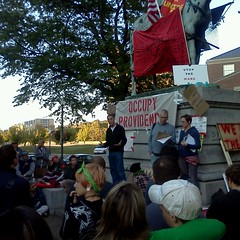
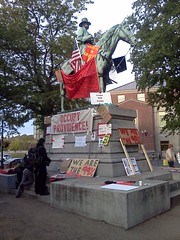
However, most social movements have compelling narratives of their own. Occupy is no exception. I encountered a multitude of viewpoints on a variety of issues. Perhaps most informative were the responses that Occupiers gave when I asked for their opinion on potential problemswith the movement. I decided to do this because I wanted to break the paradigm whereby protestors state goals and pundits critique them. I wanted to hear the movement’s critiques of itself: what might go wrong, what needs to happen to “succeed,” what “succeeding” will actually look like, and so on. I didn’t get answers to all of these questions, but I’m planning to go back, and hopefully to camp outfor at least a couple nights in the next few days as an embedded Occupier-journalist.
Here are some of the stories of the people I met today. All photos are mine, except where otherwise noted, and are available under a Creative Commons license (details).
Gretchen and Arrash Jaber: “More than just politics”
Gretchen didn’t specify her education level she’s currently employed full-time as a mother (the couple’s son was at the tent with them). When I asked why they were there, Gretchen told me she wanted to “be a part of making a change.” Arrash has a bachelor’s degree and is currently employed. He feels that the Occupy movement isn’t a purely political one he listed “cleaning up the city [Providence]” as one of the things he thought local Occupiers could organize around, in addition to some more hypothetical concepts like uniting globally with the working- and middle-classes.
In my experience, when a nonviolent demonstration begins to treat the police as its enemies, it immediately begins to lose both moral and practical high ground. During the hour or so I spent at Occupy Providence today, I saw Providence police officers engaged in friendly conversation with various organizers. Arrash put words on this phenomenon: he wanted the demonstrators to respect the police and to talk to them. I pointed out that the police are often part of the very same working class that liberal social movements commonly try to represent he agreed emphatically.
The Providence Fire Department has also lent material support to Occupy Providence they donated three tents, which were at the time of my visit being used for media. The fire department had even gone so far as to label one of the tents (click for larger images):
Jonathan Lewis: “This is what an activist dreams about.”
Jonathan is self-employed in nonviolence training. He’s the founder of the Positive Peace Warrior Network. After driving by Occupy Providence yesterday, he decided to return to camp out. I asked him about the way forward could Occupy’s success in physically bringing people together be translated into legislative action? Would the movement’s grassroots energy need to be sacrificed? He replied that it’s “not an either-or” that it’s about “displaying unity” between these two fronts. His enthusiasm for in-person organizing was balanced by this pragmatic approach to the messy process of electoral politics another good sign for Occupy as it progresses.
Kyla Coburn and Andy Trench: “Targeted change”
Kyla and Andy work together as interior designers. They’d just arrived at the park with their two children when I met them. Andy was largely on kid duty, so Kyla did most of the talking Andy said they shared the same brain anyway.
One of Kyla’s primary concerns was message clarity she believes it will be absolutely vital in order to move Democrats. She expressed a personal desire to see Occupy coalesce around a message of “targeted change” toward corruption, rather than descending into a fiasco of “shaking a stick at the haves from the have-nots.” As we talked, she repeatedly underscored that she wasn’t there in support of a platform of anti-capitalism, but one of anti-corruption. This stands in strong contradiction to claims made by conservative media figures implying (orexplicitly stating) that Occupy is a cover for socialists (gasp!) or something else equally scary and “un-American.”
I pressed Kyla on the details of message centralization. By what process should this be accomplished? At what level? She wants to see Occupy’s message unified nationally and articulated into ten points to be disseminated, and is concerned that Occupy’s potential, namely its grassroots nature and wide appeal, could also undermine it as the “Republican media” (she named Fox News in particular) use soundbites to discredit the movement as a whole.
In too many cases, movements become bifurcated as organizers attempt to control the message while members seek to retain individuality. The fact that the individual members of Occupy are concerned with this issue is a very good sign. If Occupy does begin to articulate a national platform, I hope that individual members of the movement will be as receptive as Kyla was hopeful.
I’ll wrap up with a quote from Andy Trench, which was echoed by Michael McCarthy, one of the main organizers of Occupy Providence:
People can’t take for granted that other people are going to do that work for them. They have to come down here and actually put that time in.
Occupy Providence is on Facebook and Twitter. Connect with them there for ongoing updates, and stay tuned here for more interviews, photos, and thoughts on the movement as a whole. I’ll also be tweeting during my camp-out in the park follow me on Twitter @renaissanceboy.
20 Sep 2011
I took this video at SlutWalk Providence on Saturday. We gathered in Burnside Park and marched over I-95, ending on Broadway. I was also fortunate enough to be quoted in the Brown Daily Herald:
HarpoJaeger’14 attended “in support of other people’s right to call themselves what they want and do what they want,” he said. He added that he thought it was important for men to attend the event because “there’s a perception that feminism is only for angry women who don’t like men, but it should be possible for everyone to support women’srights.”
I’d worried about going to SlutWalk as a man that it might seem to the non-men there that I was cashing in on the excitement/activism/sexiness or trying to prove my feminist cred. I won’t even attempt to pretend I didn’t enjoy getting interviewed, but I was a bit worried that that too might be seen as stealing the stage. After all, most of the people there were female, queer, or otherwise less privileged than me, the upper-middle class straight cisgendered white Jewish guy who showed up wearing a t-shirt for a privately-funded elite political institutionafter taking school-subsidized public transportation down the hill from my Ivy League university.
So I felt a bit extraneous. Here I am, in just about as great a position in society as anyone can be, listening to queer speakers, speakers who make seventy-seven cents to my dollarand speakerswho are victims of rape and domestic abuse. What on earth can I contribute as an activist? Isn’t my presence insulting to people who actually deal with gender discrimination and sexual violence on a daily basis? I’m no doubt guilty of some of the things that we were protesting!
Feminism, like any movement for social change, is constantly derided and marginalized through the use of distortions of fact and motive. Conservative media, anti-feminist figures and institutions, and the day-to-day sexism in our society conspire to denigrate feminism as the last refuge of a man-hater (does that make me a self-hating man?). SlutWalk is part of a rising tide of new feminism, completely outside of that false zero-sum paradigm. The theoretical and academic infrastructure has existed for a while, but it’s only recently that I’ve started to see the philosophy playing out in real life, especially outside of the realm of “materially, financially privileged white women.” But it’s happening.
So:
I SlutWalked in place of those who could not be there. Victims of domestic or sexual violence. Victims of pay discrimination who have to work extra time to make the same money as their male colleagues. Victims of informal and formal structures that devalue women for being women.
I SlutWalked in support of slut self-determination. The only person who can decide whether to call someone a slut is that someone themself.
And I SlutWalked because this is everyone’s feminism. This is your feminism, his feminism, her feminism, hir feminism, and my feminism. This is what a feminist looks like.
05 Jul 2011
About 30 minutes after writing my last post, I got mugged. On the side of a busy road, in broad daylight. Ciertamente, soy un gringo! I was using my phone outside the Instituto Cultural for a few minutes, and a dude ran up to me, flicking a switchblade out of his pocket. Dame , dame el telfono! — Give me the phone! Obviously, I did. I’m mostly glad that he didn’t take my wallet or stab me – plenty to be grateful for.
A good friend of mine got me the book Whatever It Takes for my recent birthday. It’s about Geoffrey Canada and the Harlem Children’s Zone, an organization he created that takes a fundamentally different approach to fighting poverty than any other I’ve ever heard of. The book is a) incredibly well-written, b) dealing with subjects that are both fascinating and vital, and c) the only book I brought on this trip, so I’ve now read it cover-to-cover 3 times.
HCZ was created out of a frustration with the way that existing social service organizations intrinsically single out subgroups within poor populations to receive aid. This is especially true (and especially problematic) in education.
For example, I grew up attending two wonderful charter schools. I wouldn’t trade the education I received at them for anything, but it’s a huge privilege to have attended. Despite the fact that charter schools are open to anyone, it takes a certain kind of parent to investigate alternatives to a district school, to enter the charter school lottery, and to commit to the extra work that attending a charter school often entails (transportation, etc.). At their best, charter schools are laboratories for new ideas in education, prioritizing community outreach and underserved populations, but at their worst, they reinforce existing class and race divisions. Dedicated administrators, like those at the schools I attended, have their work cut out for them in trying to avoid the latter.
This dynamic is present in lots of organizations, and Geoffrey Canada wanted to change it. HCZ is comprised of a series of programs (parenting help, preschool, elementary, middle, and high school, and more), designed to provide a seamless “conveyor belt” of social improvement programs for children from before they’re even born to the time they graduate high school, and beyond. It’s based on the substantial research showing that the earlier you intervene in an underserved and underskilled child’s life, the easier it is to get them back on track. Canada wanted to change the lives not just of a few kids who he happened to reach, but of the entire population of Harlem, in a rigorous and scalable fashion. HCZ gets far closer to that goal than any other organization I’ve ever heard of, and is likely to be the only way to make any kind of serious headway on urban poverty.
So once the initial shock of being on the wrong end of a knife died down (and after realizing that my mugger probably needs the phone more than I do), I got to thinking about the sort of society that creates people like him. Obviously, being poor doesn’t excuse turning to crime — but lecturing about the moral failings of the poor doesn’t do much for society either. In Mexico, as in Harlem, there are probably specific interventions, especially in the lives of children, that could drastically transform the way society treats its poor, and drastically increase their upward mobility. Effectively, HCZ is a systems thinking approach to poverty, and it marks a much more realistic way of looking at the problem, one that we upper-middle class white Americans should try to internalize. Given the amount of resources we have available to deal with poverty, we should be doing a much better job of thinking about how to allocate them effectively.
02 Jul 2011
I arrived in Oaxaca later yesterday afternoon after a 7-hour bus ride from Mexico City. I managed to get to my host family’s house pretty easily, although it was a bit nerve-wracking to knock on the door of the place I’ll be living for the next month, without knowing anything about them. They’ve turned out to be wonderful, though – a big family with plenty of little kids, who I’m told are the best Spanish teachers one could ask for.
The student who was staying with this family before I arrived (we overlapped by a day) remarkedthat it seemsOaxacans never sleep – it seems like there’s always some sort of celebration going on. Based on last night, I’m inclined to agree. I had an outrageously comical “first-night-in-a-new-country” experience. Since it was a Friday night, folks were out on the street pretty late, but I was exhausted, so I went to bed around 10. Pretty much as soon as I closed my door, an entire parade went by my window, complete with mariachi band and police cars. They were even shooting off fireworks in the street! And of course each time they did, every car alarm in the city would go off, and then all the dogs would start barking at the car alarms, and then parrots would start shrieking at the dogs. It was about the noisiest welcome to Oaxaca I could have asked for!
We had orientation at the ICO this morning, and I had a delicious lunch in the Zocalo, a big open pedestrian square, with a lot of shops – somewhat touristy, but really fun (and made infinitely better by the two men playing ‘”Dance the Night Away” and Coldplay’s “Clocks” on a marimba the size of my bed). I also got a chance to go inside the church of Santo Domingo, which is covered almost completely with gold leaf, and is just about the most beautiful building I’ve ever seen. <div id='gallery-7' class='gallery galleryid-2124 gallery-columns-5 gallery-size-thumbnail'>
-

-

-

-

-

<dl class='gallery-item'>
<dt class='gallery-icon landscape'>
 </dt>
</dl>
</dt>
</dl>
-

-

-

-

-
El Instituto Cultural de Oaxaca
</div>
Tomorrow, to an archeological dig. Classes start on Monday. Vamos!
30 Jun 2011
For the next month, this blog is going to focus primarily, if not exclusively, on my travels in Mexico. I flew into Mexico City today, and will remain here until Friday morning, when I’ll be taking a bus down to Oaxaca. I’ll be studying Spanish there at the Instituto Cultural for the month of July.
It’s been a whirlwind afternoon – Mexico City is huge and confusing, especially since my Spanish is pretty abysmal at this point. I’ve seen some pretty desperate poverty so far, but I don’t think I’ve seen enough of the city to have a good grasp of it as a whole. The neighborhood I’m in also seems to have some fairly affluent folks as well.
This should be a very interesting month. Stay tuned…
 The only visible change you’ll notice is that when you load an individual completed poem, it now appears in a fancy modal dialog. Underlying this small adjustment is a deep rethinking of how the app treats completed poems. Previously, it loaded them all into state when it was launched, displaying only the first 50, and providing the user with a button to show more. I also wanted each poem to have a pseudo-permalink, so if you wanted to send one to a friend, for example, you could just copy the URL. So I gave each poem on the screen an
The only visible change you’ll notice is that when you load an individual completed poem, it now appears in a fancy modal dialog. Underlying this small adjustment is a deep rethinking of how the app treats completed poems. Previously, it loaded them all into state when it was launched, displaying only the first 50, and providing the user with a button to show more. I also wanted each poem to have a pseudo-permalink, so if you wanted to send one to a friend, for example, you could just copy the URL. So I gave each poem on the screen an  Finally, I use
Finally, I use 
 I activated
I activated 
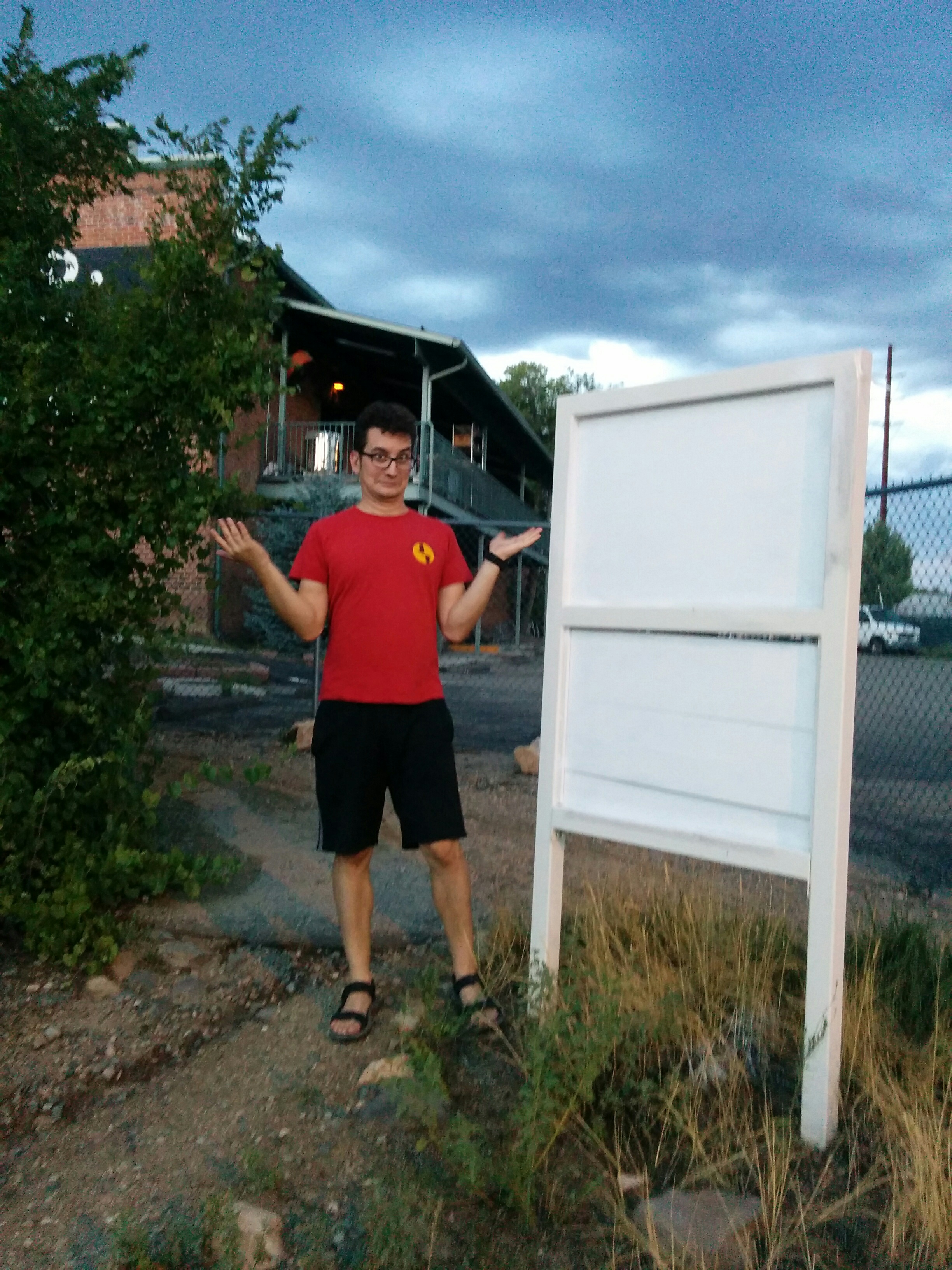
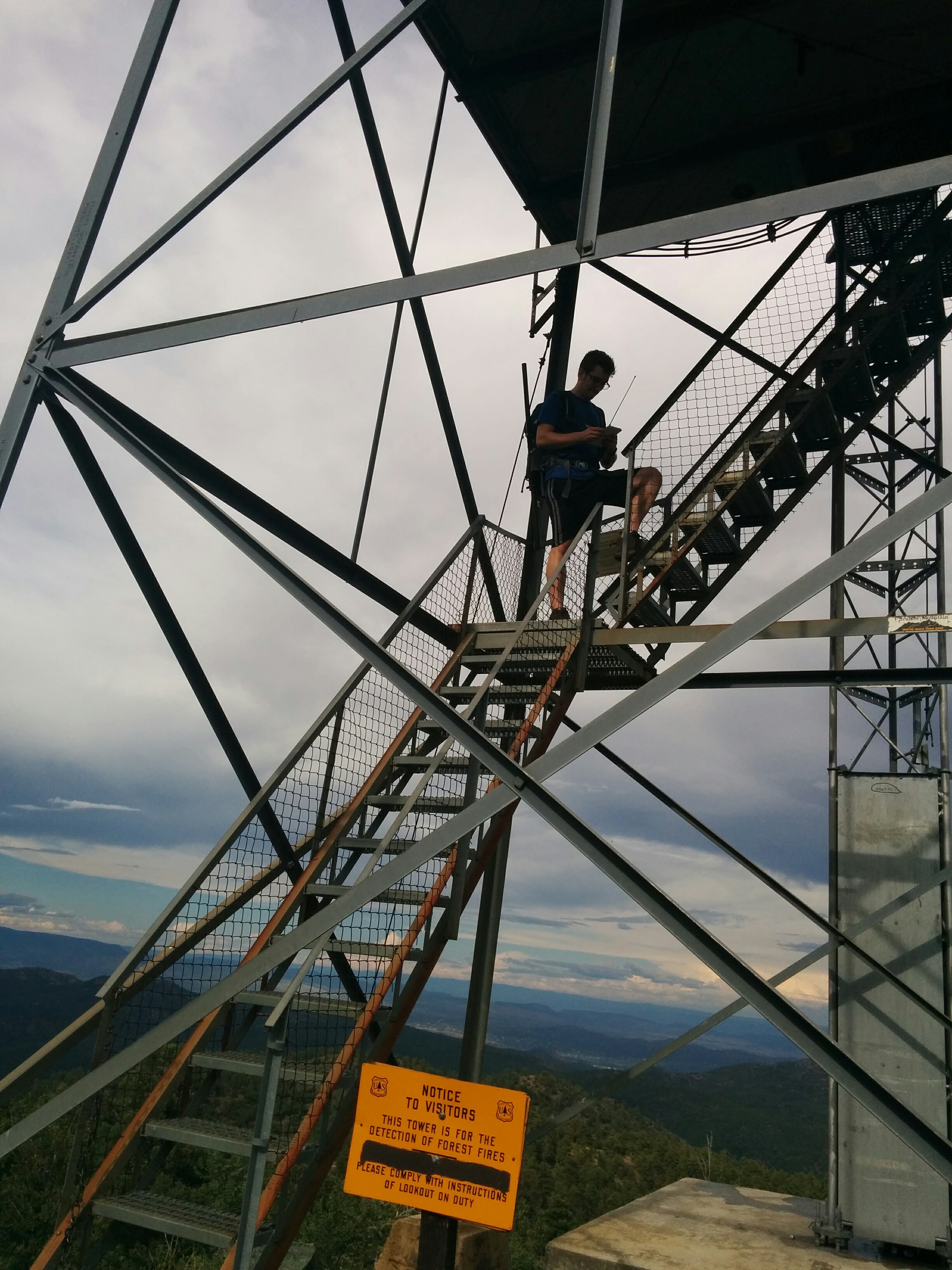
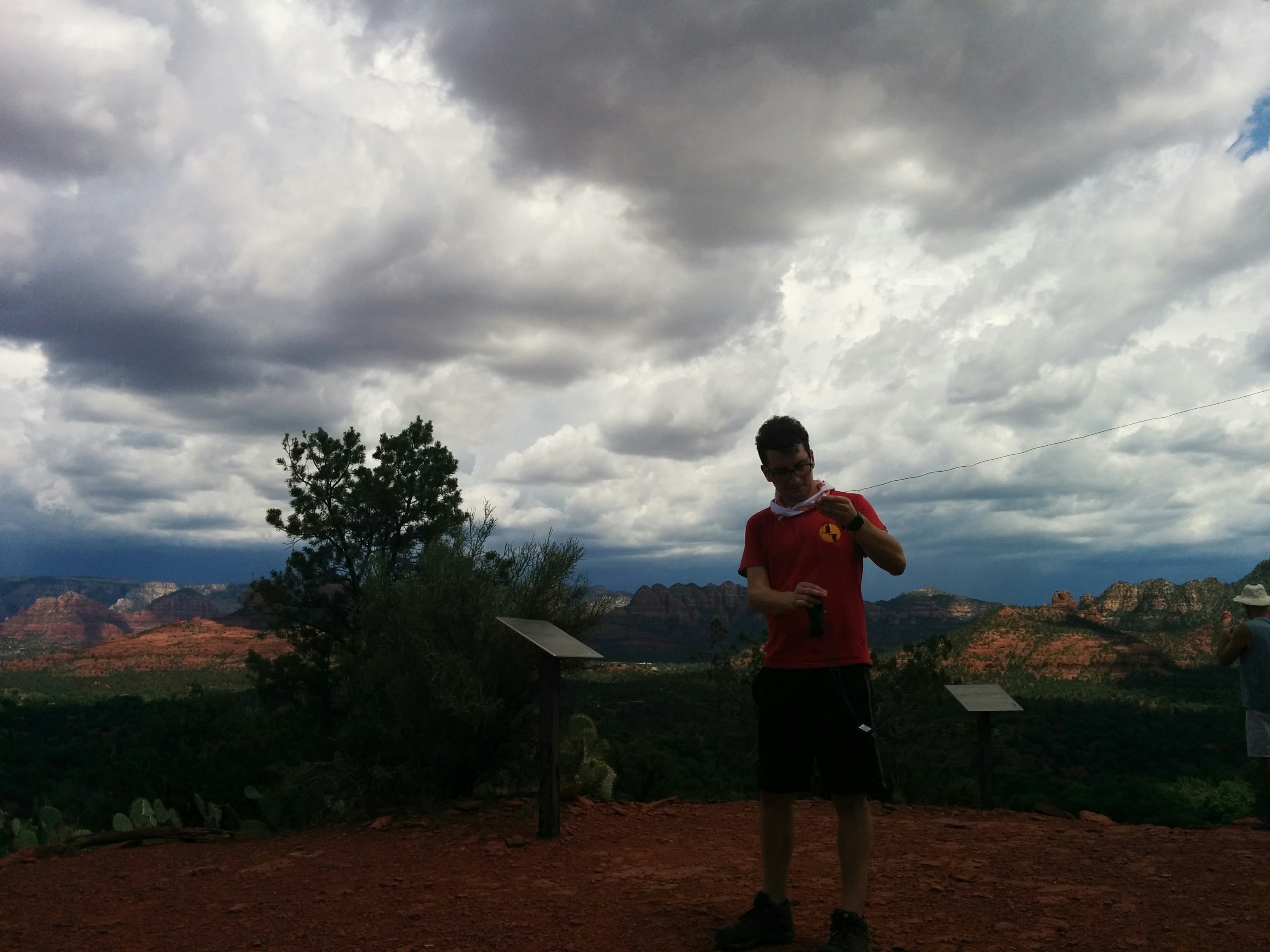
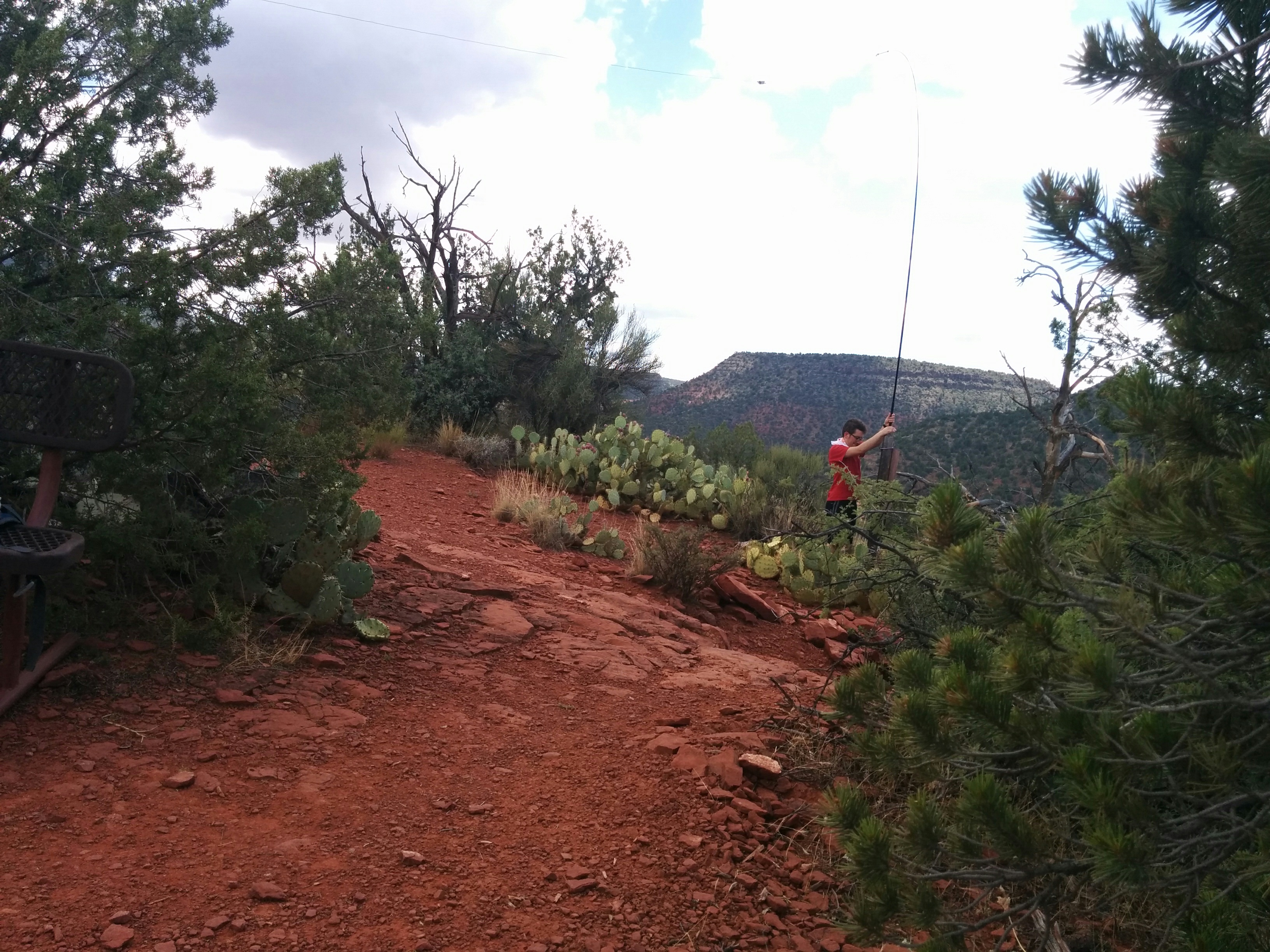
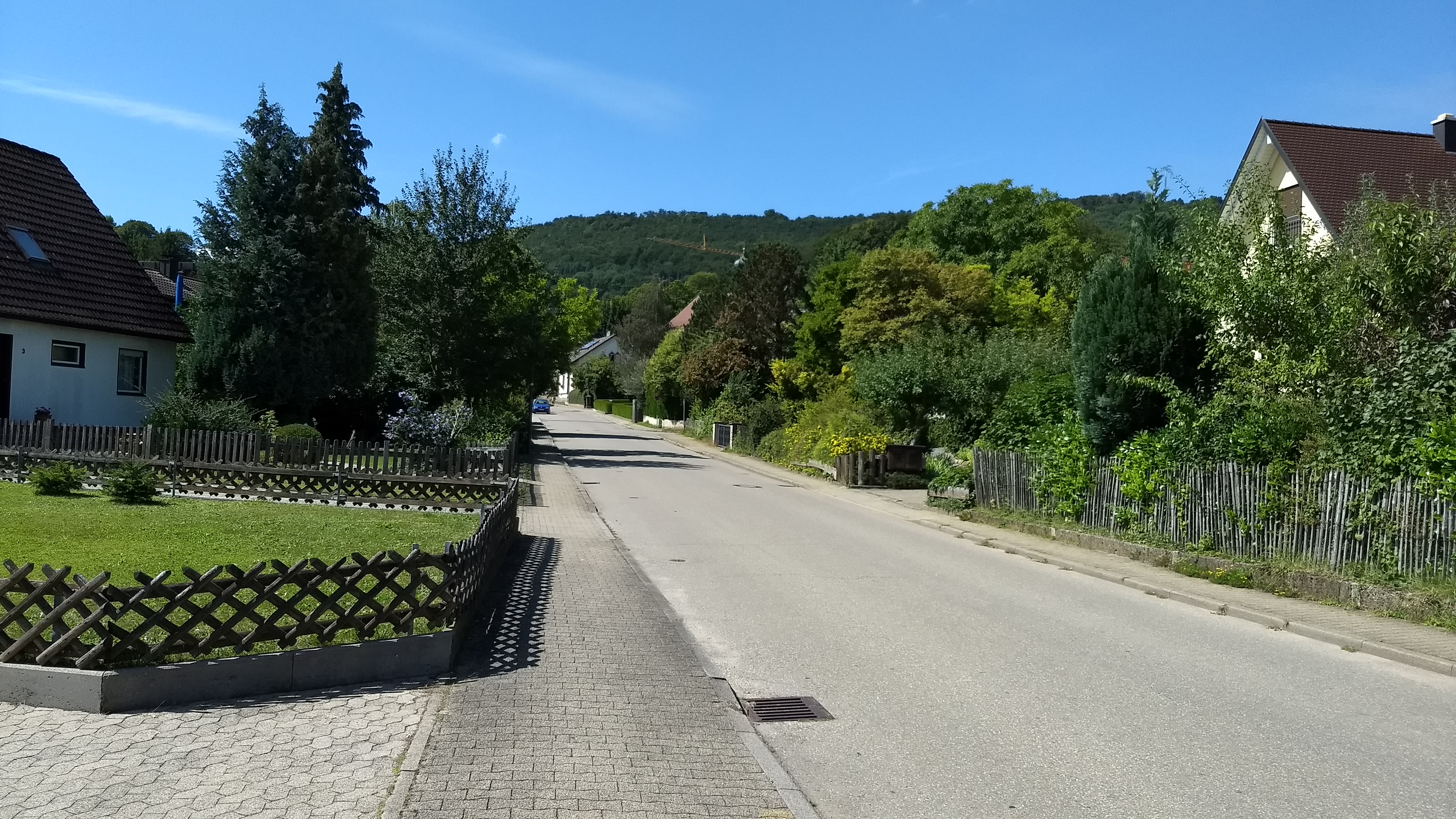
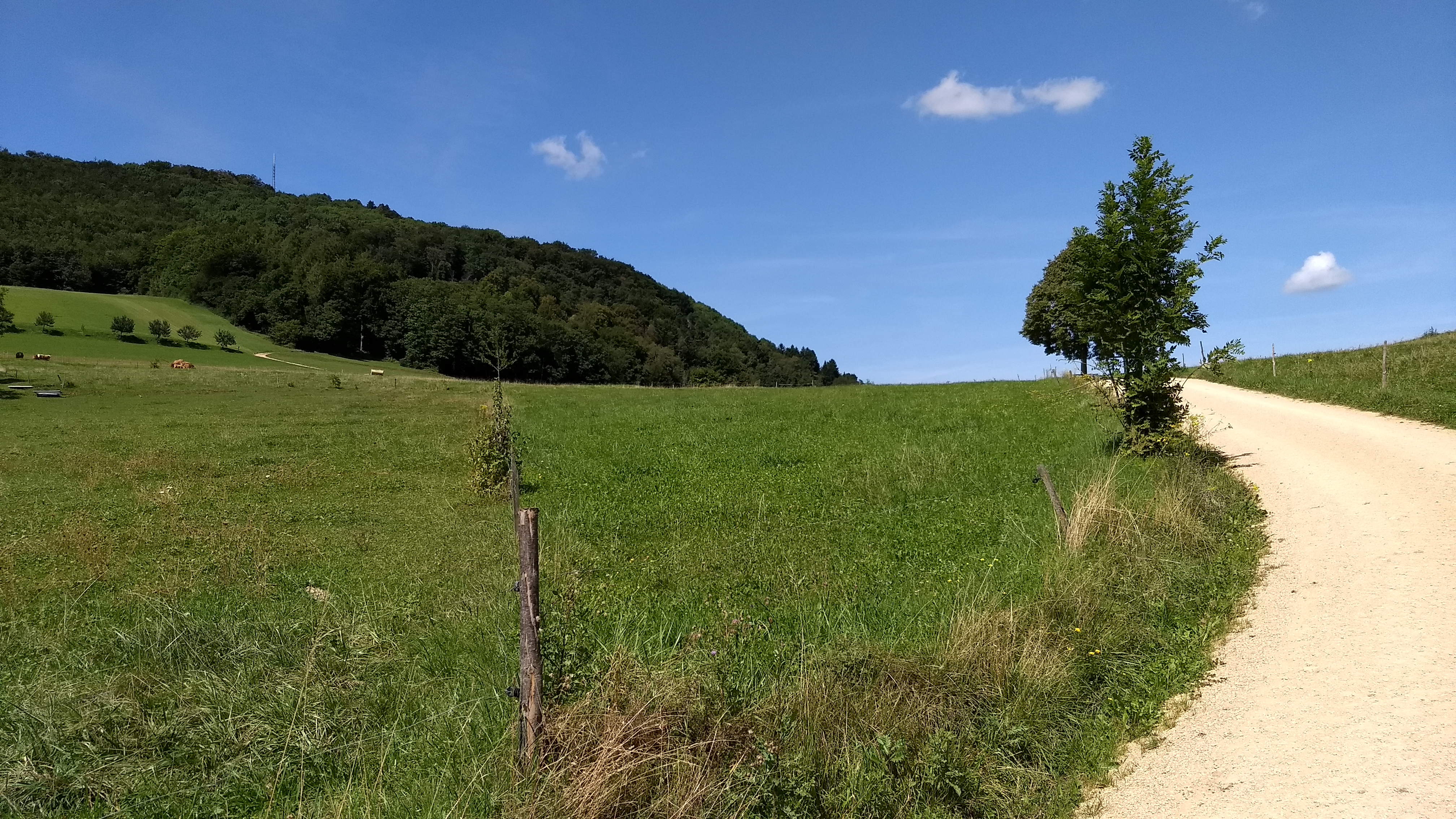
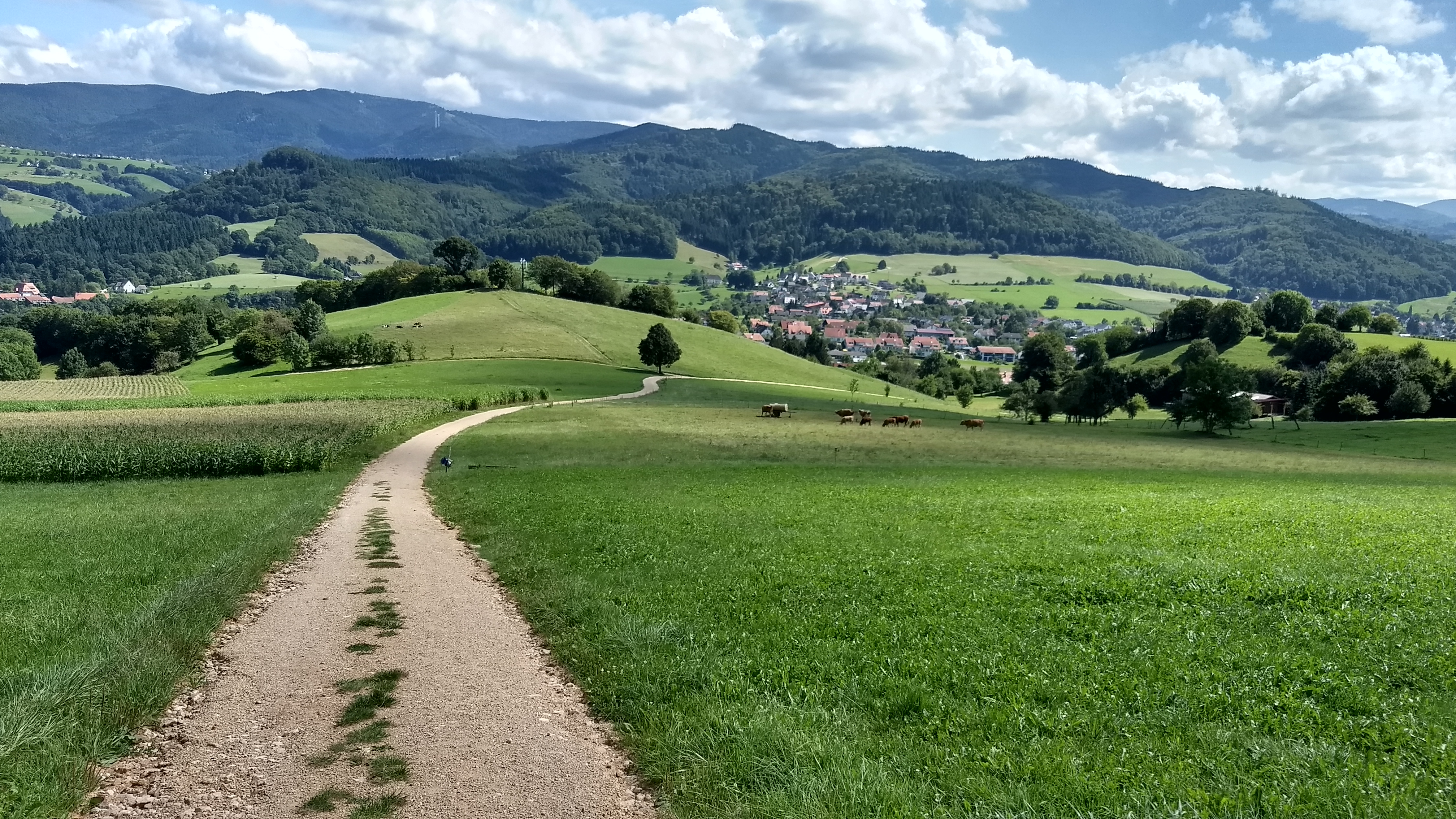

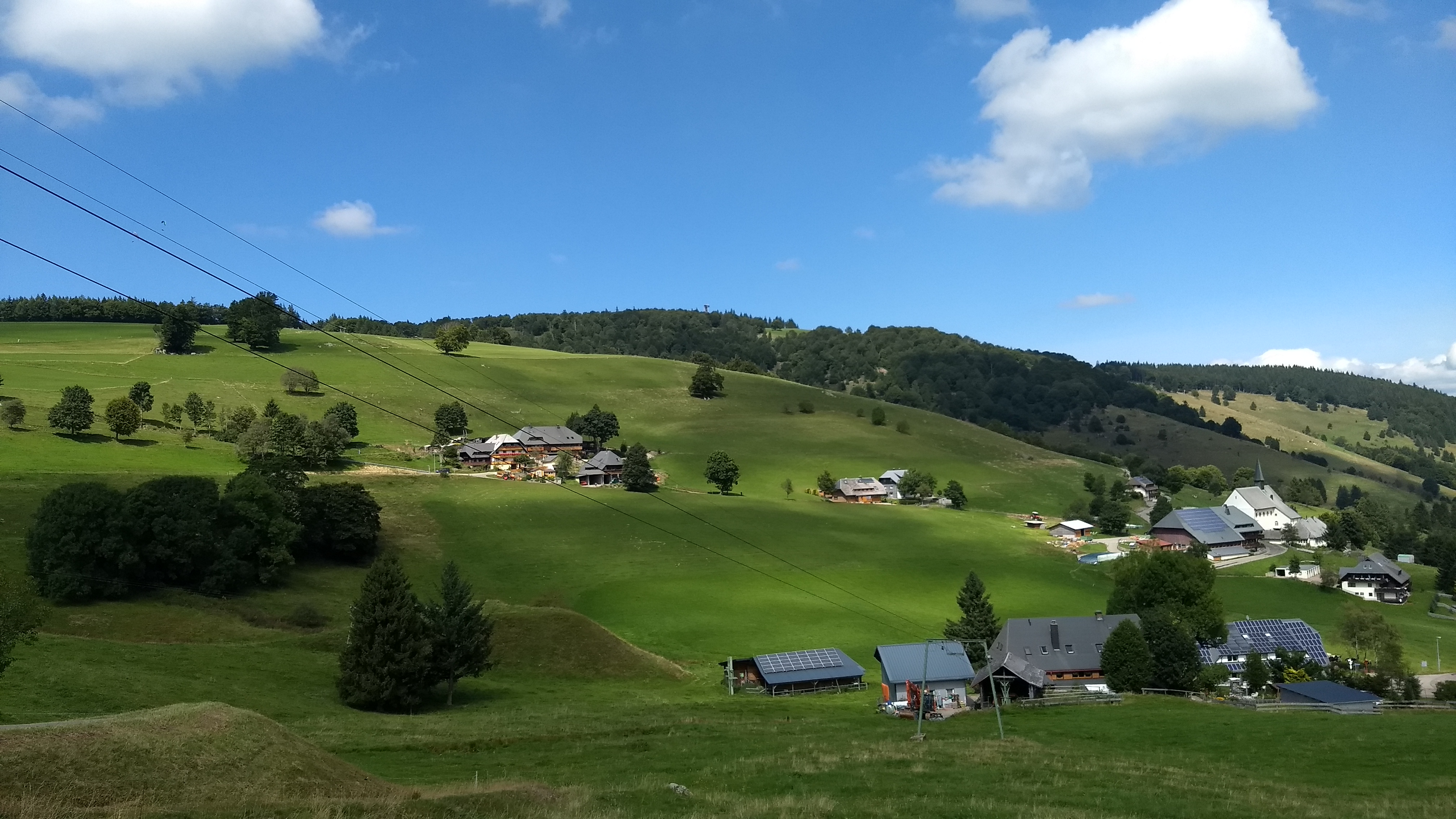
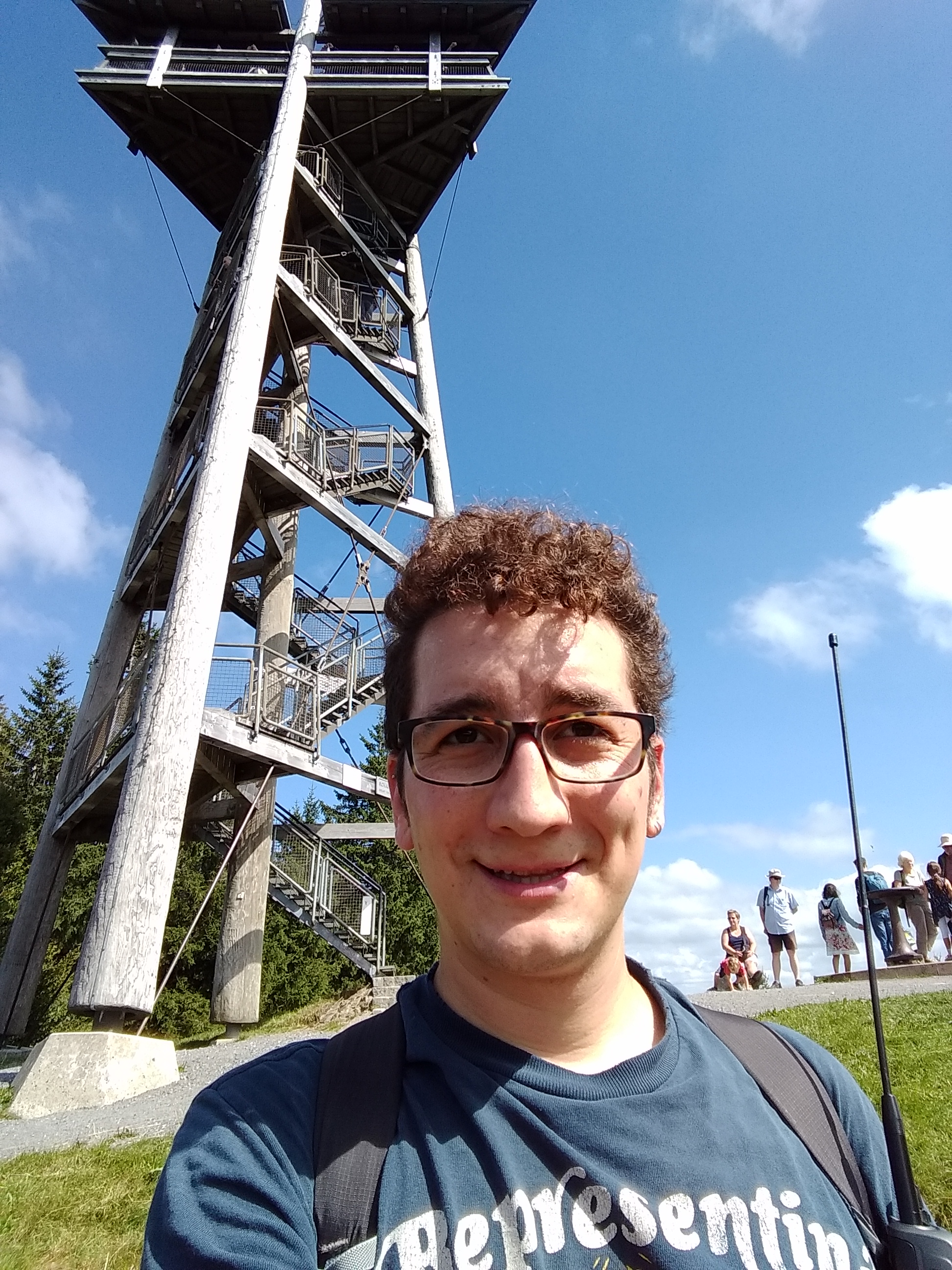
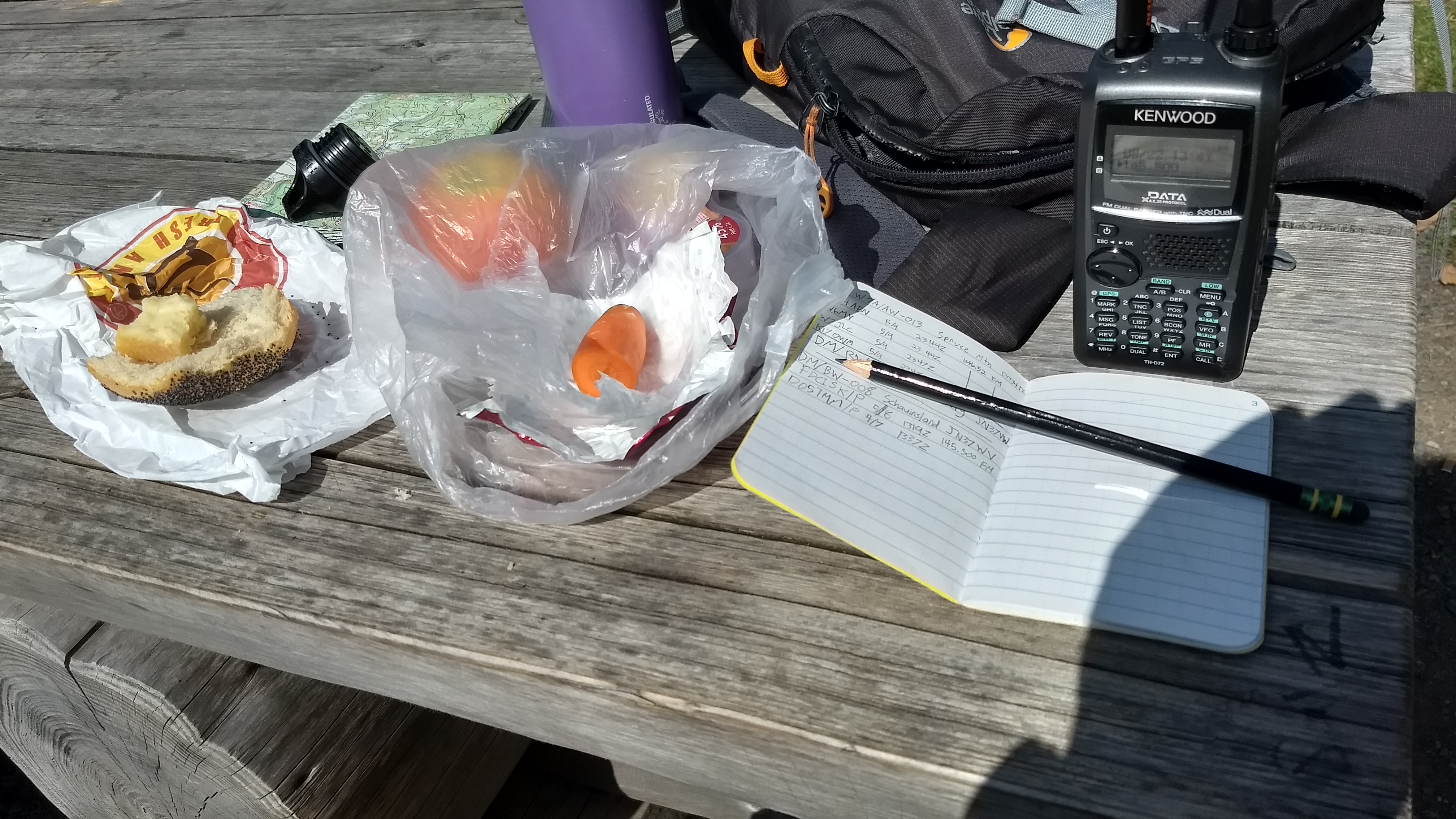
 A small crowd turned out for the Tucson Refuse Fascism march on the evening of Saturday, July 15. We were accompanied by about 20 uniformed TPD officers, and two Nazis. Here they are in Catalina Park, shortly before we started moving.
A small crowd turned out for the Tucson Refuse Fascism march on the evening of Saturday, July 15. We were accompanied by about 20 uniformed TPD officers, and two Nazis. Here they are in Catalina Park, shortly before we started moving. Our group was small, but spirited. Especially with our police escort, we attracted quite a lot of attention, garnering both cheers and boos from people along 4th. We talked to bystanders as we went to try to get them to join in, but the sight of a Nazi in a gas mask and flak jacket probably dissuaded a lot of them.
Our group was small, but spirited. Especially with our police escort, we attracted quite a lot of attention, garnering both cheers and boos from people along 4th. We talked to bystanders as we went to try to get them to join in, but the sight of a Nazi in a gas mask and flak jacket probably dissuaded a lot of them. Here’s a nice picture I took today of Seattle’s Union Station. Unfortunately, Amtrak trains depart from a different station (King Street), but that one looks nice too. I’ll try to get a good picture on the way out. And you can certainly expect lots of pictures, or at least some posts, from the train (if the Internet is passable) or my various stops along the way.
Here’s a nice picture I took today of Seattle’s Union Station. Unfortunately, Amtrak trains depart from a different station (King Street), but that one looks nice too. I’ll try to get a good picture on the way out. And you can certainly expect lots of pictures, or at least some posts, from the train (if the Internet is passable) or my various stops along the way. I returned from the
I returned from the  After unloading my haul and looking it all over, I realized that a set of a switched outlets and an over-dramatic red indicator light are a natural combination. So I combined them. Outlets are made to be wired in parallel banks, so it wasn’t hard to figure out where to wire in the light. My ham training stood in me good stead! After a couple runs to the local hardware store (why is it that whenever you decide not to bring your piece with you, you can’t find what you need, and whenever you preemptively bring it, it ends up being extraneous?), I had what I needed.
After unloading my haul and looking it all over, I realized that a set of a switched outlets and an over-dramatic red indicator light are a natural combination. So I combined them. Outlets are made to be wired in parallel banks, so it wasn’t hard to figure out where to wire in the light. My ham training stood in me good stead! After a couple runs to the local hardware store (why is it that whenever you decide not to bring your piece with you, you can’t find what you need, and whenever you preemptively bring it, it ends up being extraneous?), I had what I needed. I bought a new junction box and and mounted the light in it. The portion of the indicator light that lives inside the box is a little bulky, so it was necessary to use some creative hardware to accomodate. Once I integrate this power supply unit into my radio setup (a subject for a future post), I may decide to reconfigure it slightly to optimize placement and visibility of the indicator light, and based on space constraints. But the leads I wired in are long enough to accomodate a lot of possible permutations, so it shouldn’t be hard. And it works!
I bought a new junction box and and mounted the light in it. The portion of the indicator light that lives inside the box is a little bulky, so it was necessary to use some creative hardware to accomodate. Once I integrate this power supply unit into my radio setup (a subject for a future post), I may decide to reconfigure it slightly to optimize placement and visibility of the indicator light, and based on space constraints. But the leads I wired in are long enough to accomodate a lot of possible permutations, so it shouldn’t be hard. And it works!
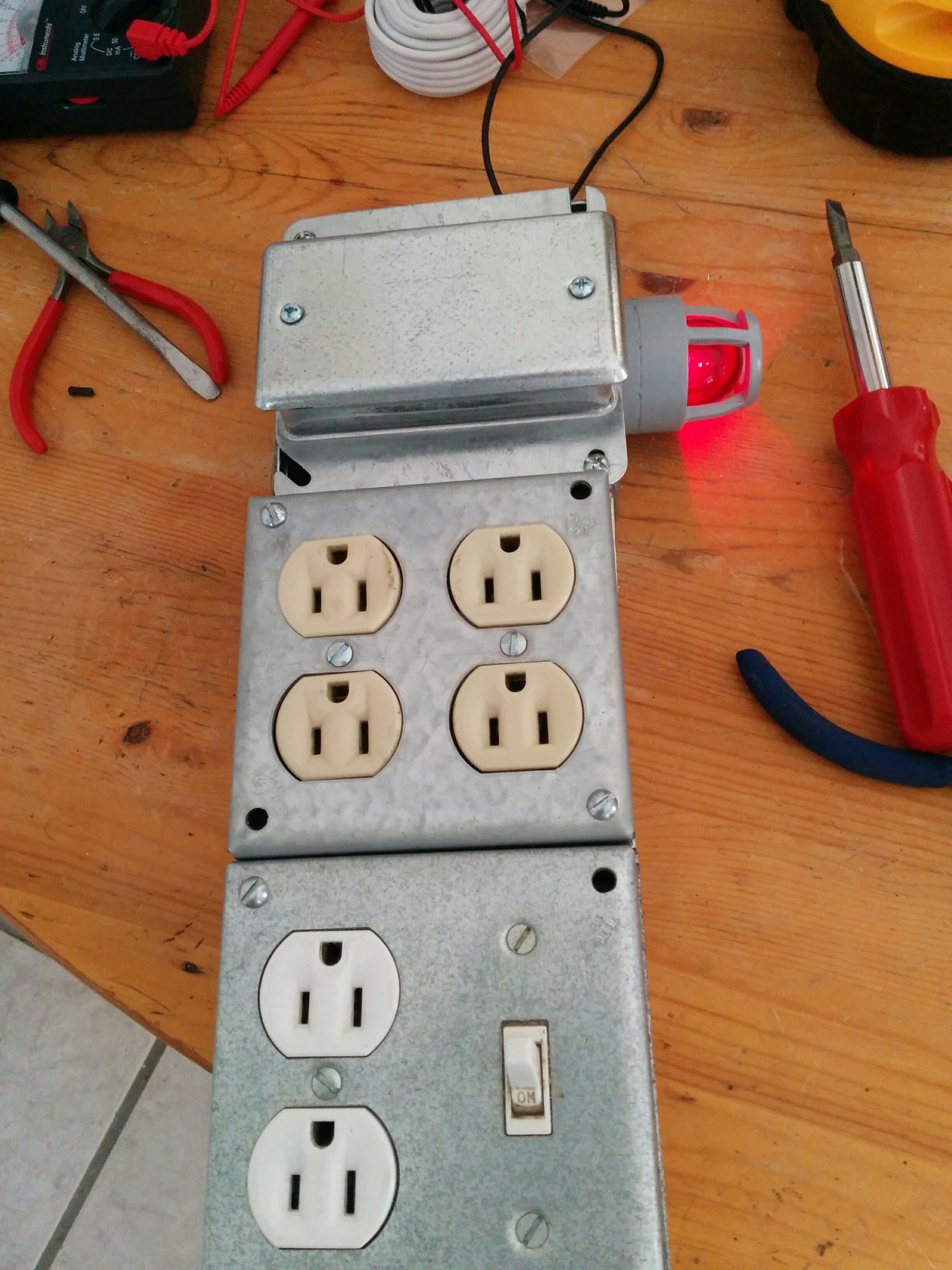
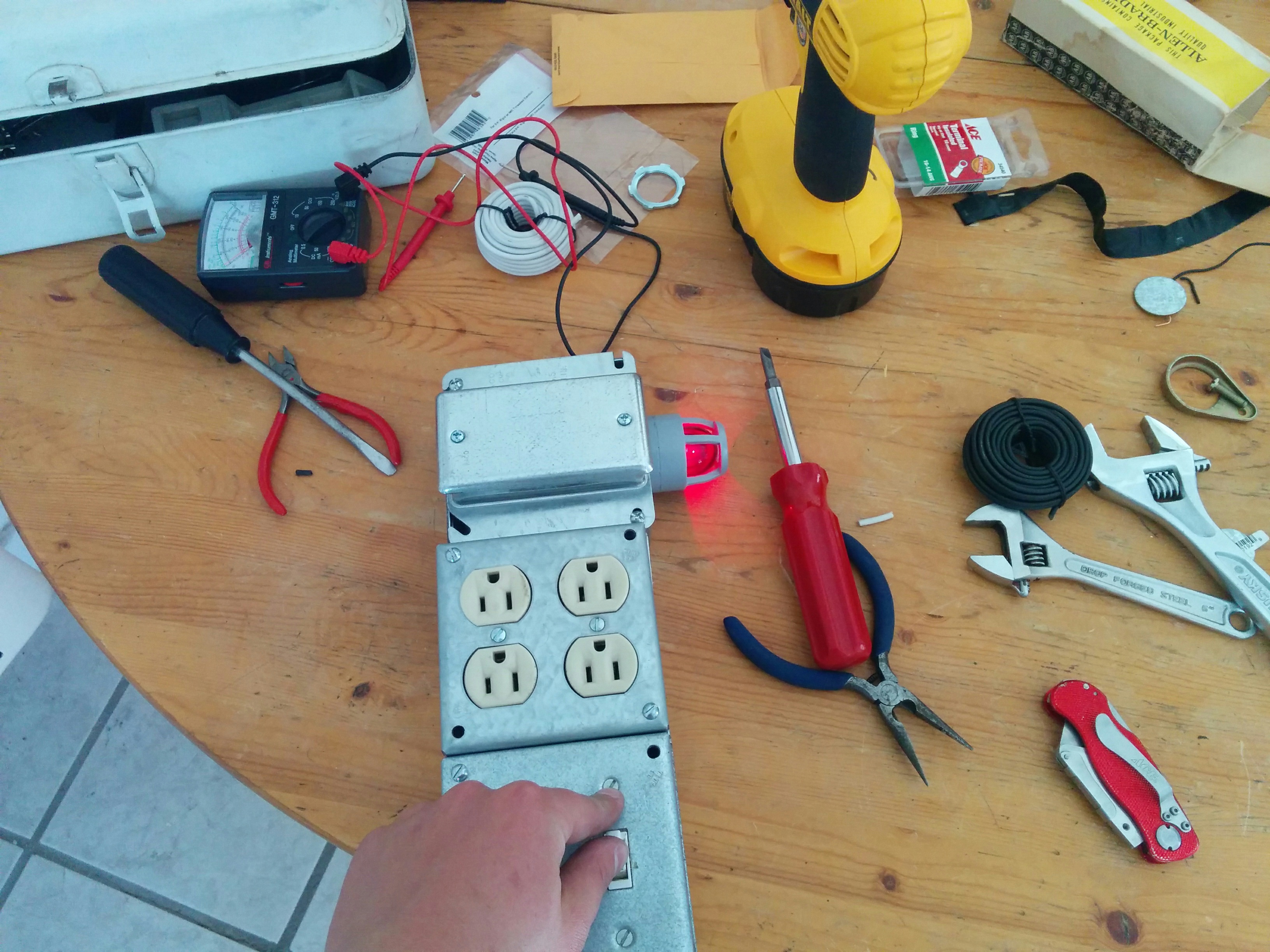
 Over the last couple weeks I’ve been working on a number of house projects. The biggest is a coop and run for our new chickens! The run is about 8’ x 8’, and the (numerous) corner brackets ensure that it’ll remain quite sturdy even with untreated wood (which you can use out here in the desert). The uprights are sunk about 1’ into the ground. It took a lot of digging and pickaxing to get through the
Over the last couple weeks I’ve been working on a number of house projects. The biggest is a coop and run for our new chickens! The run is about 8’ x 8’, and the (numerous) corner brackets ensure that it’ll remain quite sturdy even with untreated wood (which you can use out here in the desert). The uprights are sunk about 1’ into the ground. It took a lot of digging and pickaxing to get through the  The coop is an approximately 4’ x 4’ cube, with 1/4” plywood bottom and back. The right side and front (from these photos’ perspective) are simple poultry mesh with a corrugated synthetic sun guard material. The top and left side have 2x4 frames hinged to the coop. The top has poultry mesh under the corrugated tin, so it can be left open during the day for additional airflow. The left side opens into the run.
The coop is an approximately 4’ x 4’ cube, with 1/4” plywood bottom and back. The right side and front (from these photos’ perspective) are simple poultry mesh with a corrugated synthetic sun guard material. The top and left side have 2x4 frames hinged to the coop. The top has poultry mesh under the corrugated tin, so it can be left open during the day for additional airflow. The left side opens into the run. I’ve started making sauerkraut! I’m using
I’ve started making sauerkraut! I’m using 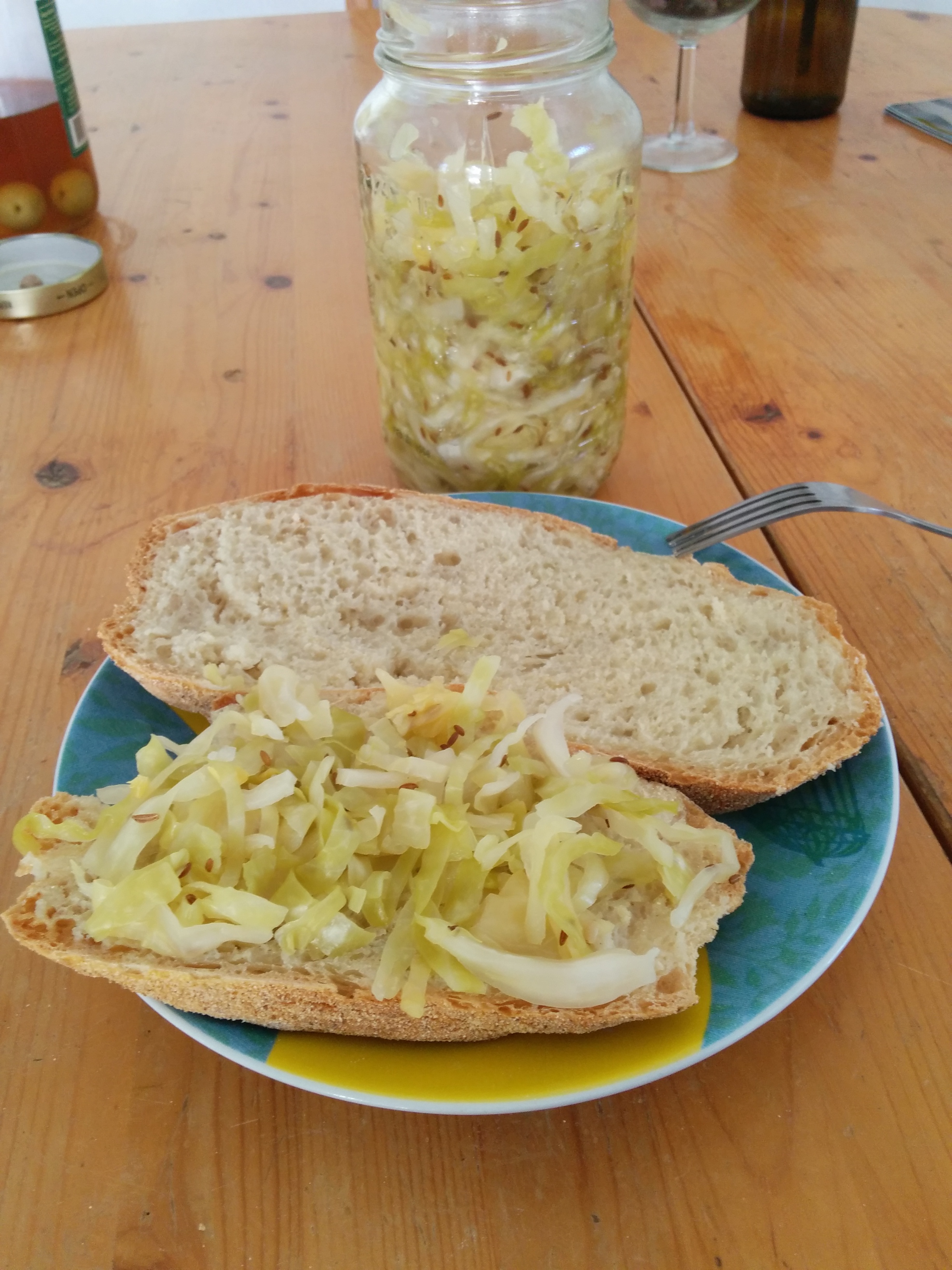
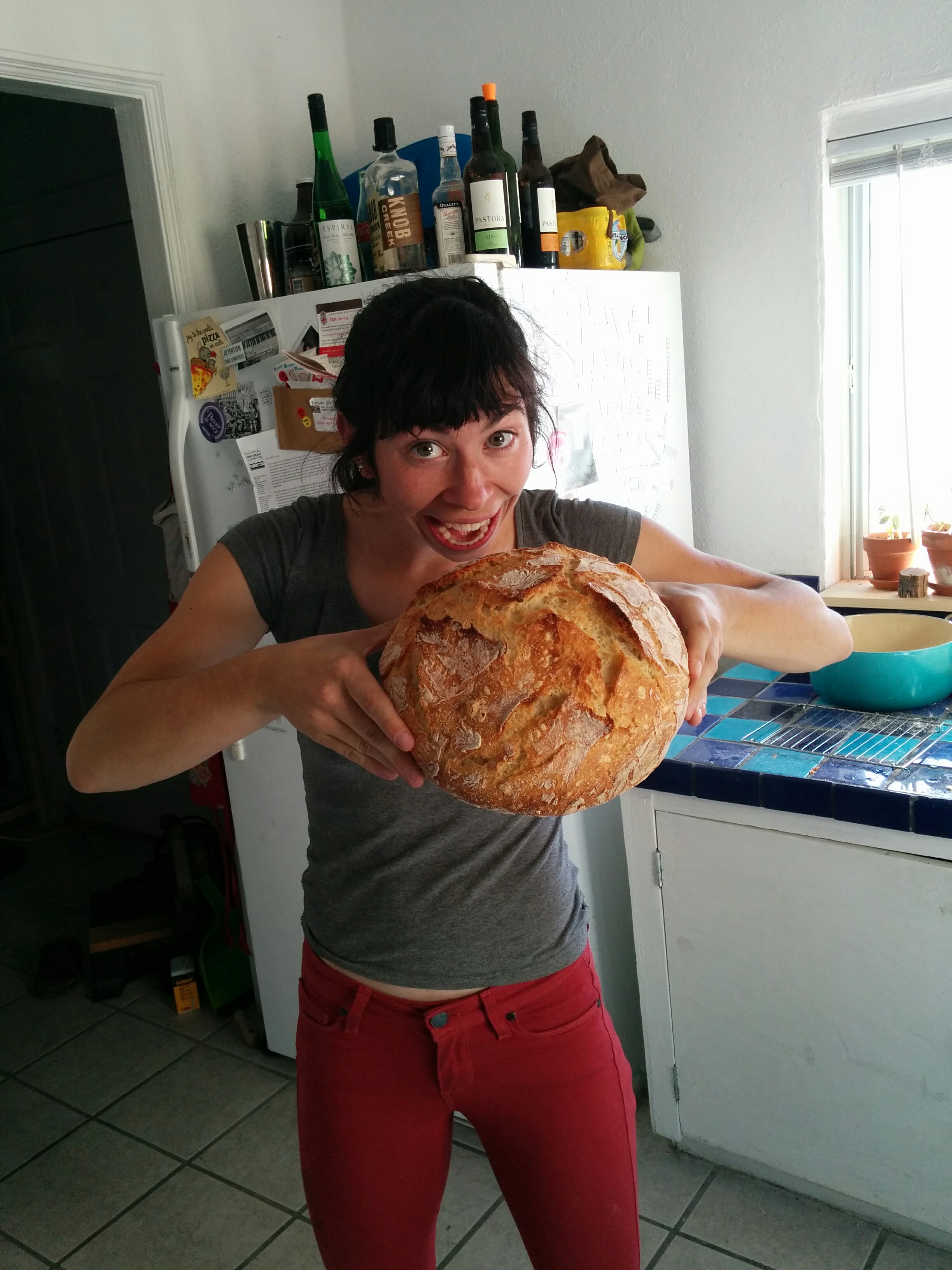



 I don’t want to be blindly supportive of the Occupy movement. I don’t want to blindly condemn it. I don’t want to be blind at all. In a movement as experiential as this one, joining in is the best way to learn. I’m describing myself as an embedded journalist-activist, and, while I largely support the movement’s (ethereal) goals, I’m retaining some measure of aloofness. From a journalistic perspective, this lets me critique the movement while being involved enough to feel like I’m part of a real and constructive conversation, rather than acting like a distant analyst with little connection the emotions and ideas this movement is bursting with.
I don’t want to be blindly supportive of the Occupy movement. I don’t want to blindly condemn it. I don’t want to be blind at all. In a movement as experiential as this one, joining in is the best way to learn. I’m describing myself as an embedded journalist-activist, and, while I largely support the movement’s (ethereal) goals, I’m retaining some measure of aloofness. From a journalistic perspective, this lets me critique the movement while being involved enough to feel like I’m part of a real and constructive conversation, rather than acting like a distant analyst with little connection the emotions and ideas this movement is bursting with. From 1999 to 2001, Artemis was homeless, living on Thayer Street on College Hill. The
From 1999 to 2001, Artemis was homeless, living on Thayer Street on College Hill. The 




